
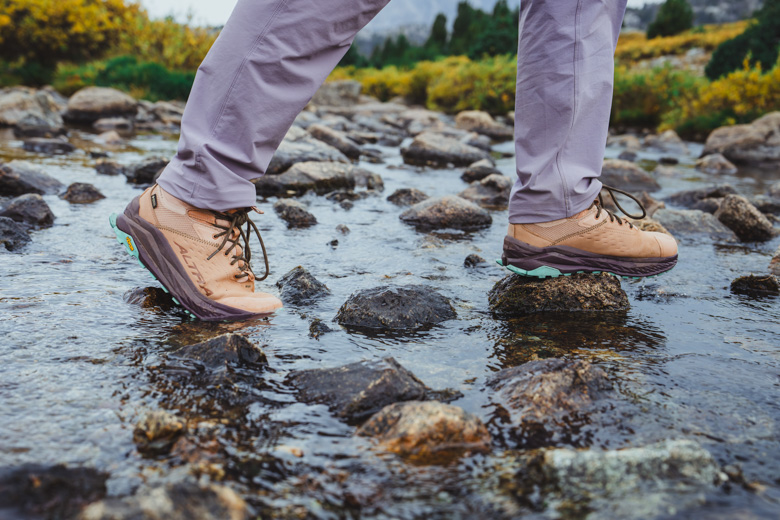
Waterproof hiking boots are a go-to choice for everything from muddy day hikes to multi-day backpacking trips through unpredictable weather. While breathability and weight are key factors in any hiking footwear, staying dry is a top priority for hikers venturing into wet conditions or planning on crossing streams. Options range from lightweight, fast-moving designs to burly leather models built to handle long distances and heavy loads, each with their own benefits in comfort, support, and durability. After months and miles of testing waterproof boots on sun-warmed glaciers in Patagonia and shoulder season trails in the Pacific Northwest, we’ve narrowed down a list of the best waterproof hiking boots for 2025. For more information, see our comparison tables and buying advice below the picks, along with details about our testing process. For a wider look at the market, check out our list of the best hiking boots, which contains both waterproof and non-waterproof options.
Editor's note: We updated this guide on July 14, 2025, to update our top pick, the Salomon X Ultra Mid Gore-Tex, to its newest version after some extended testing on backpacking trips and day hikes across Washington state.
 Category: Light/midweight
Category: Light/midweight
Upper: Leather/textile
Waterproofing: Gore-Tex
What we like: A well-balanced boot with excellent traction and on-trail performance.
What we don’t: Not supportive or protective enough for tough backpacking trips.
Salomon’s flagship X Ultra series has been a fan favorite among hikers for years, thanks to its reliability and versatility. Version 5 in the series is nimble underfoot, but the ankle-tall collar and thick toe protection also offer a nice dose of support and protection. While far from the stiffest option on the market, we found the X Ultra 5 stable while hauling heavy backpacking gear into the Pasayten Wilderness of Washington, and the winged lacing system makes it easy to snug this boot down. What’s more, Salomon’s Contragrip outsole has proven to be just as all-terrain as the brand claims—it easily grips onto wet rocks, slippery roots, and mud. Salomon also didn’t skimp out on the Gore-Tex waterproofing, which provides reliable protection in creek crossings. In the end, the X Ultra 5 is a jack-of-all-trades boot ready to take on lightweight backpacking and day hiking missions, making it a solid all-around choice for sub-$200.
That said, this versatile boot does have a few limitations. To start, its lightweight build doesn’t offer the foot and ankle support of a stiffer boot—Salomon’s Quest 4 below has better foot and ankle support for demanding backpacking trips. Similarly, the lack of underfoot cushion can lead to soreness over rough terrain. Lastly, we had some issues with fit in the women’s version, which caused some blisters in testing (we recommend sizing down by half a size). Gripes aside, we think the 5 is an overall upgrade from the outgoing 4, especially in terms of durability. Both the upper and outsole have proven much more hard-wearing than the last version, and we’re optimistic about the longevity of the boot.
Read more: Salomon X Ultra 5 Mid Gore-Tex review (women's version)
See the Men's X Ultra 5 Mid Gore-Tex See the Women's X Ultra 5 Mid Gore-Tex

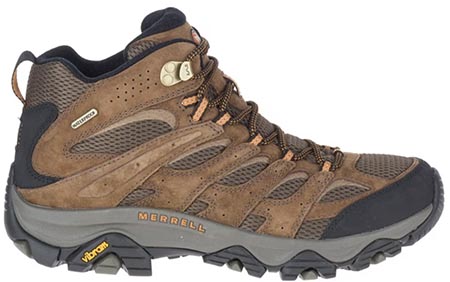 Category: Light/midweight
Category: Light/midweight
Upper: Leather/mesh
Waterproofing: Merrell DRY
What we like: Out-of-the-box comfort, impressive durability, and won’t break the bank.
What we don’t: Low collar isn’t supportive enough for heavy loads; not the most nimble.
Despite what the $150 price point might have you believe, the Merrell Moab 3 WP is anything but budget quality. In fact, this boot has impressed us with its durability, comfort, and support on a variety of day hikes and light backpacking trips. It has an out-of-the-box comfort with generous padding, a soft interior, roomy toe box, and the leather and mesh upper strike a nice balance between breathability and on-trail protection. We tested this boot on a rainy hiking trip on the Olympic coast and found its waterproofing similarly reliable as Gore-Tex without the price hike. And despite the many miles we’ve put into our Moabs over the years, durability has yet to be a main concern, and the latest version is built with recycled materials (interior mesh and laces) that have proved just as hardwearing as past iterations.
Our gripes with the Merrell Moab 3 can be boiled down to two main points: First, like the X Ultra 5 above, the Moab 3 doesn’t offer enough support for harder backpacking endeavors. The low collar and single eyelet leave more risk for ankle-rolling and foot fatigue than heavier-duty boots. On the other hand, the Moab’s burly build is somewhat outdated in the recent market which has trended sharply towards athletic and minimalist. But while the Moabs don’t have exaggerated rockered profiles like other lightweight models here, we haven’t felt overly clunky in them either. Overall, the Moab 3 remains a compelling design for casual or hikers, earning it a spot among our favorites.
Read more: Moab 3 Mid WP review (men's version)
See the Men's Merrell Moab 3 Mid WP See the Women's Merrell Moab 3 Mid WP

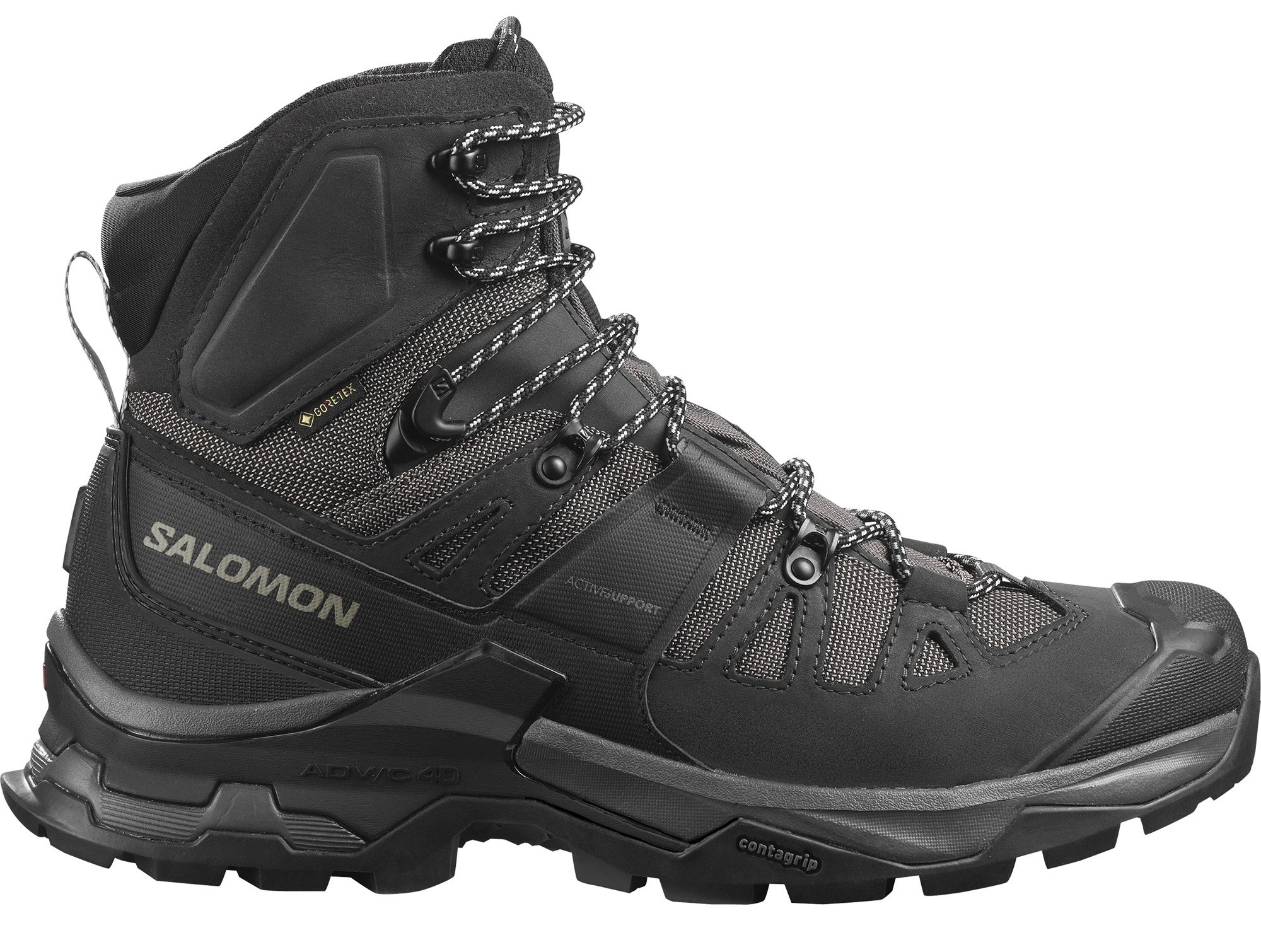 Category: Mid/heavyweight
Category: Mid/heavyweight
Upper: Leather/textile
Waterproofing: Gore-Tex
What we like: A heavy-duty and supportive boot ready to tackle demanding backpacking trips.
What we don't: Overkill for casual users; expensive.
The X Ultra and Moab above are serviceable options for short backpacking trips and day hikes, but if you’re planning on hauling a heavy backpack over many miles, you’ll want a highly supportive and protective boot. Salomon’s Quest 4 is one of our favorites for this reason: With a high collar and secure lacing system, padding along the ankle, a soft interior lining, and underfoot shock absorption, the Quest is comfortable and supportive on tricky trails and under heavy loads. We found it a reliable companion for off-trail wandering and technical stream crossings: The Contragrip tread grabbed onto submerged rocks, and the Gore-Tex waterproofing and water-resistant collar kept moisture at bay. And while $230 is no small amount of money to spend on a pair of boots, the Quest 4 has held up well to the trail abuse we’ve subjected it to so far.
With a decent amount of forefoot flex, the Quest 4 isn’t totally lost on mild terrain either, but it’s certainly most at home on technical hikes. Those who stick to groomed trails can save a lot of weight and money by going with the X Ultra 5 above or with any of the other lightweight boots here. Users have reported some durability issues, specifically with the Quest’s sole, but we have yet to experience any concerns in our own testing. In fact, we’ve been really impressed with this boot’s ability to keep up with demanding hikes, and we’re quick to suggest it to anyone wanting to kick their backpacking trips up a notch. For other midweight options, check out Lowa's Renegade Evo GTX and Keen's Targhee IV below.
Read more: men's Salomon Quest 4 review and women's Salomon Quest 4 review
See the Men's Salomon Quest 4 GTX See the Women's Salomon Quest 4 GTX

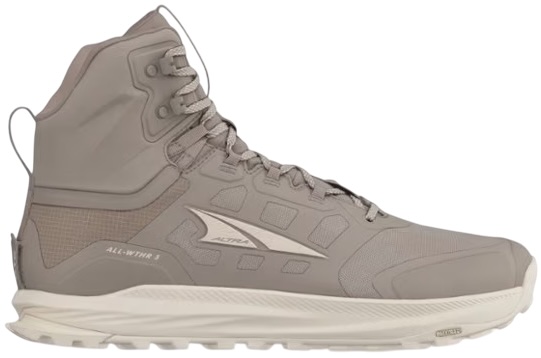 Category: Lightweight
Category: Lightweight
Upper: Recycled mesh
Waterproofing: Cosmo lining
What we like: A lightweight hiker with a wide toe box and zero drop sole.
What we don’t: Not the most supportive or grippy on wet terrain.
Altra’s best known in the running world for their wide toe box kicks, but their Lone Peak 9 Waterproof Mid is a popular choice among hikers and fastpackers. The hype is in the wide forefoot—which encourages your toes to spread as they would barefoot—but the Lone Peak 9 is worth more than its shape. The midsole provides a moderate amount of cushioning for rocky trails, and while the zero-drop design (meaning there’s no height difference in the sole between the heel and the toe) takes some getting used to, we like how it encourages a natural stride. Its lightweight and flexible construction provides running shoe-like agility, and we’ve found ourselves reaching for it for quick day missions on local trails. And we’ve had luck doing so year-round: The integrated waterproof bootie offers great protection from muddy trails and consistent drizzles, securing a spot in our kit for early-season jaunts.
The Lone Peak 9 Mid’s flexible collar and lack of underfoot support won’t offer enough reinforcement for heavy backpacking missions, but we’ve taken them out on a few weekend overnight treks with little foot soreness to show for it. To be sure, those used to shoes with lots of underfoot support will want to ease into this design with some lighter hikes. We’ve also had some issues with the grippiness of Altra’s MaxTrac traction, and have come close to slipping on damp bridges and slick rocks. Lastly, we think that many of Altra’s offerings can be polarizing in their style (the wide toe box leans duck-footed), and we often aren’t fans of the women’s-specific colorways. Regardless, Altras are becoming more of a trail staple by the day as hikers become conscious about their foot health. If you want to take all-natural to the next level, check out Xero’s “barefoot” Scrambler Trail Mid below.
See the Men's Altra Lone Peak 9 WP Mid See the Women's Altra Lone Peak 9 WP Mid
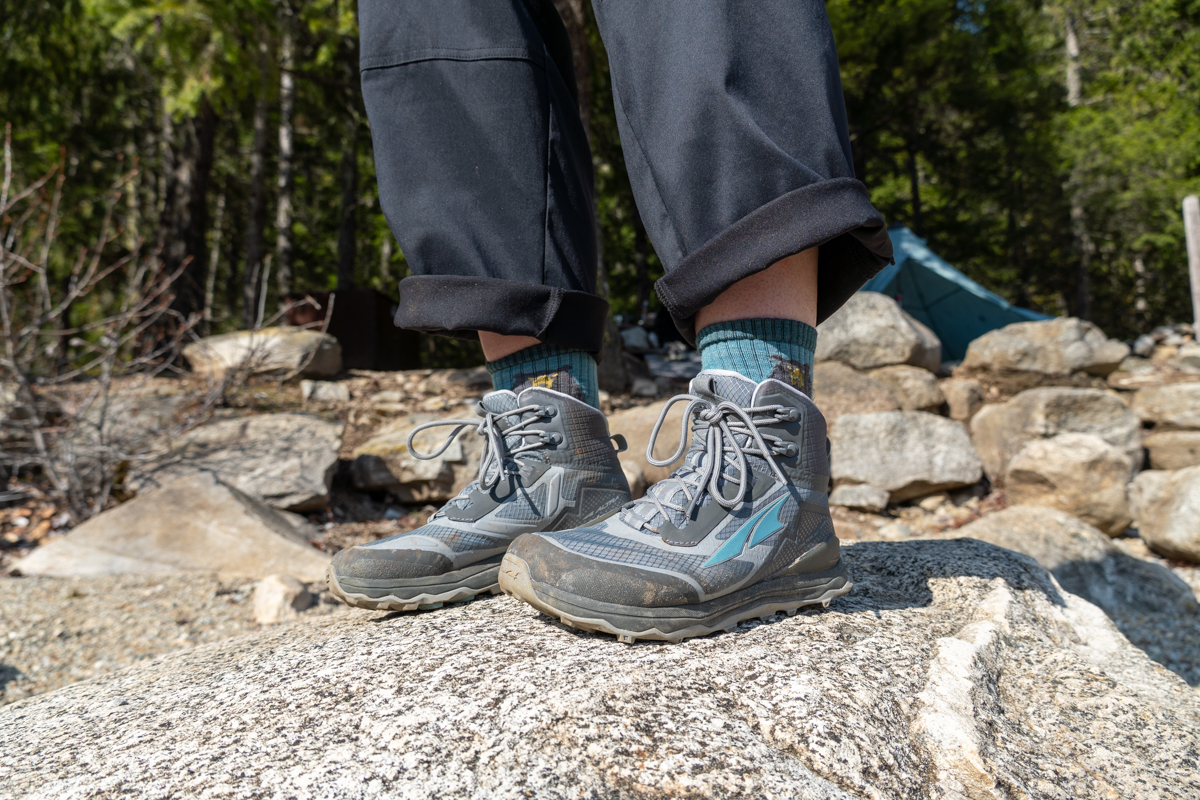
 Category: Lightweight
Category: Lightweight
Upper: Mesh/synthetic
Waterproofing: Gore-Tex
What we like: A lightweight hiking boot with a decent amount of support and protection.
What we don’t: Not the lightest boot on our list and runs a bit small.
A quick glance at the comparison table below will tell you that lightweight hiking boots have become a popular choice among hikers in recent years, and for good reason. A few ounces off your boots translates to greater efficiency on the trail and nimbleness in tricky terrain. We think Scarpa’s Rush Mid 2 GTX pulls lightweight off better than most. At under two pounds for both the men’s and women’s versions (1 lb. 13.2 oz. and 1 lb. 8.3 oz., respectively), the Rush Mid 2 is agile, comfortable, and purpose-built for covering miles. Outfitted with Gore-Tex waterproofing and Scarpa’s tacky SuperGum outsole, the Scarpa can take on creek crossings and muddy trails. They also have a generous amount of mesh along the top of the boot that offers enough breathability to prevent over-sweating in mid-summer heat.
Another glance at the comparison table will reveal that the Scarpa Rush Mid 2 GTX is not the lightest weight boot in this list—that award goes to the NNormal Tomir below. But we think that the Scarpa offers a more well-rounded take on the category, giving it greater durability and stability over most other options. The TPU frame, relatively stiff midsole, and ankle-high collar offer a surprising amount of support, enough to confidently tackle technical trails with a lightweight climbing pack. Our main gripe is its sizing: Our tester found the Rush to fit small and sized up for greater comfort. Once dialed, the Rush has easily become one of our favorite boots for light missions in the alpine. Note: The women's version of the Rush 2 Mid GTX may be tough to find online at the time of publishing, but we expect it to be restocked soon.
Read more: Scarpa Rush 2 Mid GTX review (men's version)
See the Men's Scarpa Rush 2 Mid GTX See the Women's Scarpa Rush 2 Mid GTX
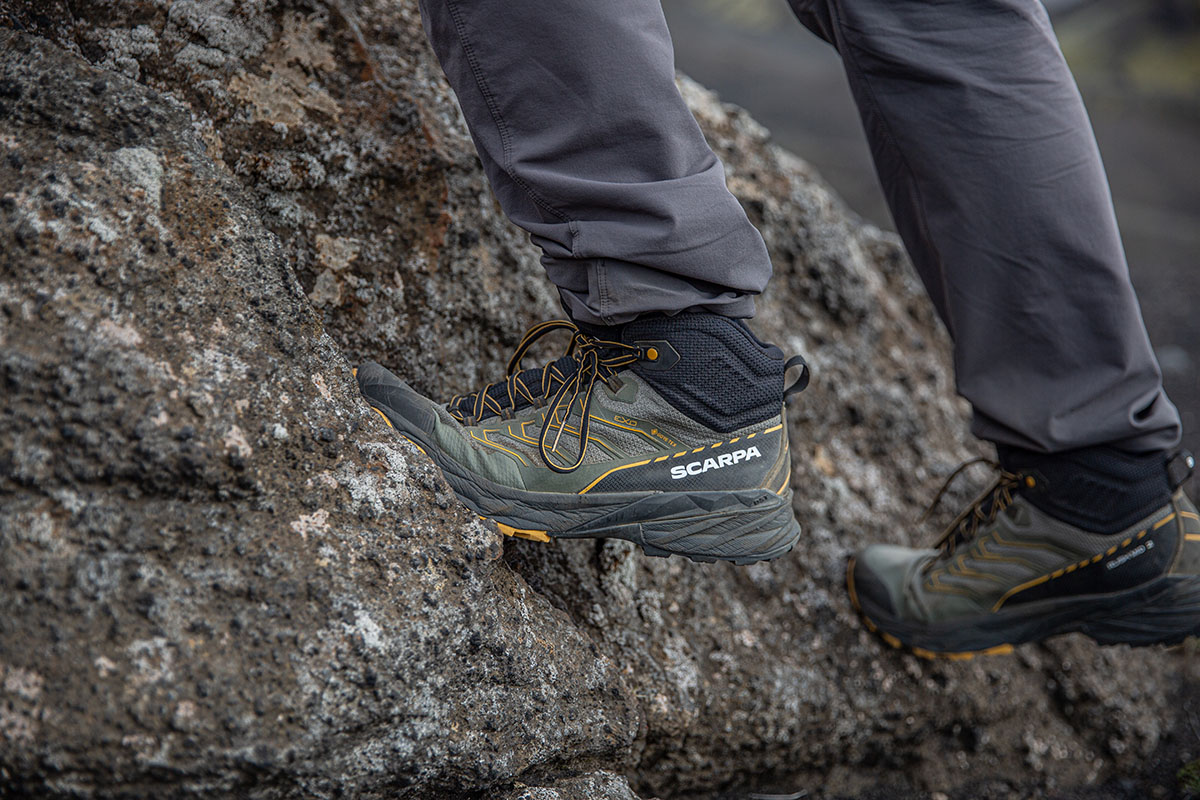
 Category: Midweight
Category: Midweight
Upper: Leather/mesh
Waterproofing: Gore-Tex
What we like: A max-cushioned boot that balances nimbleness and support well.
What we don’t: Somewhat of a polarizing look and the outsole is prone to wear.
Like Altra, Hoka earned their footing in the trail running sphere, but they’ve since proven their hiking chops with the Anacapa 2 Mid. Opposite the Altras, Hoka is big on midsole cushion—so big that the Anacapa 2 Mids are recognizable uopn first glance by their thick rockered soles. Without exaggerating, these boots are some of the most comfortable we’ve ever worn, and it’s not just because of the cushioning: The generous fit easily accommodates swelling feet, and the mid height provides decent ankle support for tough trails. In fact, they strike a nice balance between the support of a stiff hiking boot and the nimbleness of a lightweight design. We’ve also had great luck with their material quality, including the hardwearing leather and mesh upper, premium Vibram sole, and Gore-Tex waterproofing that has yet to fail us on bog crossings and drizzly hikes.
Where the Anacapas have let us down is the durability of their outsole: The blown rubber is susceptible to damage from sharp rocks. We also aren’t the biggest fans of the low back collar which leaves the back of the shoe susceptible to water and debris. And if we’re to nitpick, the top of the collar is too stiff to properly snug the boot down tight, leaving a bit too much wiggle room for the top of our foot. Like the Altra Lone Peak, the Anacapa 2 Mid is a bit of a statement piece, but if you’re more concerned with being comfortable than keeping things low-key, they are definitely worth checking out.
Read more: Hoka Anacapa 2 Mid GTX review (men's version)
See the Men's Hoka Anacapa 2 Mid GTX See the Women's Hoka Anacapa 2 Mid

 Category: Midweight
Category: Midweight
Upper: Nubuck leather
Waterproofing: Gore-Tex
What we like: A burly leather hiker ideal for hauling serious weight.
What we don’t: Expensive and we had some durability issues with the previous version.
Salomon’s Quest 4 above is our favorite for tough backpacking missions, but Lowa’s Renegade Evo GTX is close on its heels. The Renegade leans more towards a traditional hiking boot with its leather construction, but it’s proven its ability to keep up with modern athletic hikers. It's a bit lighter weight than the Quest 4 (by about 5 ounces), but doesn’t sacrifice support and comfort to earn it: The lacing system is easy to get just right, and we’ve trusted the sturdy platform and ankle-tall collar on technical trails. And despite its reliable Gore-Tex waterproofing, the leather remains thin enough to keep this boot breathable on mid-summer hikes. A Vibram outsole and interior cushioning round out the design well, offering both confidence and comfort for long and tricky missions.
At $265, the Renegade is undeniably pricey, but we have little reason to believe they won’t hold up over the long term. We did experience some issues with wear where the sole rubber meets the leather upper on the toe in the last model, but we’re optimistic the latest version has addressed the issue (we’ll be sure to report back after testing). We also think the lacing system is a bit basic—we prefer the Quest’s lacing system for better heel-locking. But there’s little more to gripe about here. All in all, Lowa hit the mark with the Renegade Evo, and we’ve come to love it for intense, backcountry treks. For a similar (and slightly cheaper at $259) option, check out La Sportiva's Nucleo High II GTX.
Read more: men's Renegade review and women's Renegade review (prior versions)
See the Men's Lowa Renegade Evo See the Women's Lowa Renegade Evo
 Category: Light/midweight
Category: Light/midweight
Upper: Leather
Waterproofing: Gore-Tex
What we like: Approach shoe/hiking boot blend fills the lightweight mountaineering niche.
What we don’t: Not enough support for backpackers and the fit is wide.
Many rock climbers are already familiar with La Sportiva’s TX approach shoes, but the line between hiker and approacher is blurred when it comes to the TX Hike Mid Leather GTX. This boot has become a fast-favorite thanks to its underfoot confidence, comfort, and agility. When we’re packing for fast and light missions in the high alpine, the TX Hike is our go-to: It’s lightweight enough for easy boulder hopping, and the tall collar and secure lacing system give it a boost in support over other lightweight hikers The generous fit and flexible upper make it a comfortable all-day wear, and with a Gore-Tex membrane, the TX Hike is ready to take through slushy spring glaciers and alpine puddles.
While the TX Hike has proven itself in high country escapades, it’s not quite supportive enough under a heavy pack. It’s worth pointing out that we found this shoe gets softer over time, so the support you feel out of the box won’t last in seasons to come. What’s more, those with narrower feet might not find the fit they want in this shoe—we’ve found La Sportiva’s footwear to be narrow in the past, but the TX Hike is somewhat of an outlier. So long as it's comfortable, the TX Hike is definitely one to grab if you’re into moving quickly and confidently in mountainous terrain.
Read more: La Sportiva TX Hike review (women's version)
See the Men's La Sportiva TX Hike See the Women's La Sportiva TX Hike
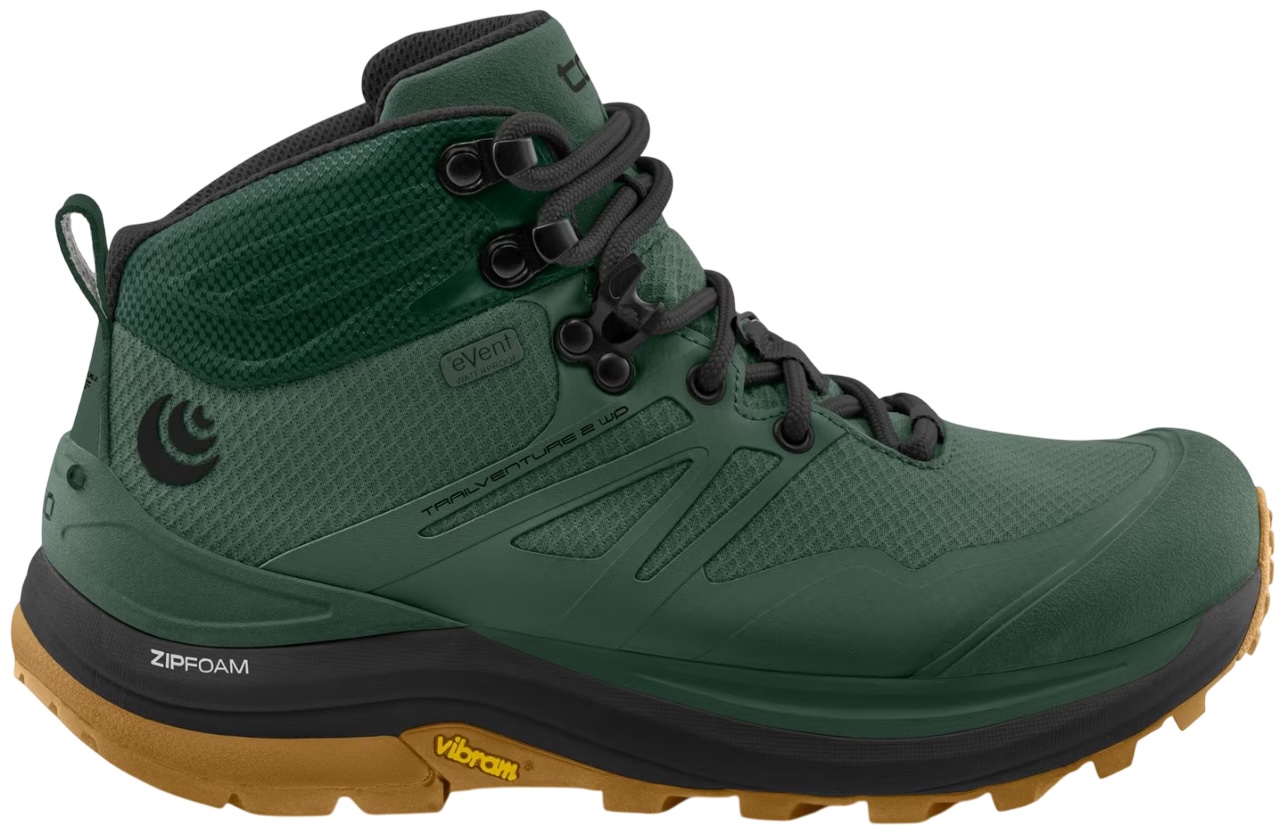 Category: Light/midweight
Category: Light/midweight
Upper: Synthetic
Waterproofing: eVent
What we like: A wide toe box boot with more support and cushion than the Altras above.
What we don’t: Still not stiff enough for dedicated backpacking and fits a bit short in the toe.
Topo Athletic's Trailventure 2 is a wide toe box alternative to Altra’s Lone Peak 9 above for those looking for a bit more underfoot cushion and support. The Trailventure 2 features a stiffer collar and larger stack height (5mm) than the Altra, giving it greater stability on off camber trails. We also prefer its Vibram Megagrip outsole, which easily gripped onto the same slippery bridge the Altras struggled to cross in testing. Its lightweight construction (1 lb. 15.8 oz. for the men’s and 1 lb. 10.2 oz. for the women’s) makes this boot an agile companion for tricky river crossings, but if you happen to make a misstep, Topo’s eVent waterproofing has you covered up to the collar.
The Trailventure isn’t a fix-all for the Altra’s shortcomings, however; it has a few downsides of its own. While certainly a step up in support over the Lone Peak’s supple build, the basic lacing system and ankle-high collar don’t provide enough stability for serious backpacking. We also had issues getting this boot tight: Between the stiff collar and thick tongue, you really have to yank the laces to secure the top of the boot. We also think that Altra pulls off the wide toe box better: The Topos were a bit short in the front of the foot, causing our first toes to strike the stiff end when hiking downhill. But if the shoe fits (we recommend trying to size up half a size), the Trailventure 2 is a worthy companion for light backpacking trips and day missions.
Read more: Topo Athletic Trailventure 2 review (women's version)
See the Men's Topo Athletic Trailventure 2 See the Women's Topo Athletic Trailventure 2
 Category: Light/midweight
Category: Light/midweight
Upper: Leather/mesh
Waterproofing: Gore-Tex
What we like: Hands down the most stylish hiking boot on this list with performance chops to boot.
What we don’t: Soft collar doesn’t make it the best choice for long distance hiking or backpacking.
Teva’s Grandview GTX Mid is a classy leather hiker that can seamlessly transition from the trail to the town, a feat not accomplished by many other boots on this list. But don’t let its snazzy styling fool you: Outfitted with a tacky Vibram outsole and premium Gore-Tex waterproofing, the Grandview can keep up on sloppy hikes and low water creek crossings without failure. We’ve been enjoying our pair on some rainy winter hikes in Bellingham, Washington, and have found them quite comfortable with their wide toe box and soft upper. As a plus, the Grandview features several sustainable materials, including recycled webbing and polyester and leather certified by the Leather Working Group whose mission is to ensure sustainable and ethical business practices within the leather industry.
While the Grandview is a great choice for day hikes, we hesitate to recommend it for those wanting to get in some serious miles. Our main concern is its support: The soft laces and lack of hooks above the eyelets make it hard to tighten these boots down, and the upper is too soft to support ankles in technical terrain. Additionally, we found that the generous heel lift (coupled with the inability to secure the heel properly at the back of the boot) pushes the foot forward to the end of the shoe. Taking the time to pull each section of the lacing tight certainly helps prevent this issue, but it’s still a concern for multi-mile comfort. But if you’re not planning on taking these boots far—think beach wandering and then to the brewery—they’ll keep your feet dry and are likely to earn you some compliments on your way.
See the Men's Teva Grandview GTX Mid See the Women's Teva Grandview GTX Mid
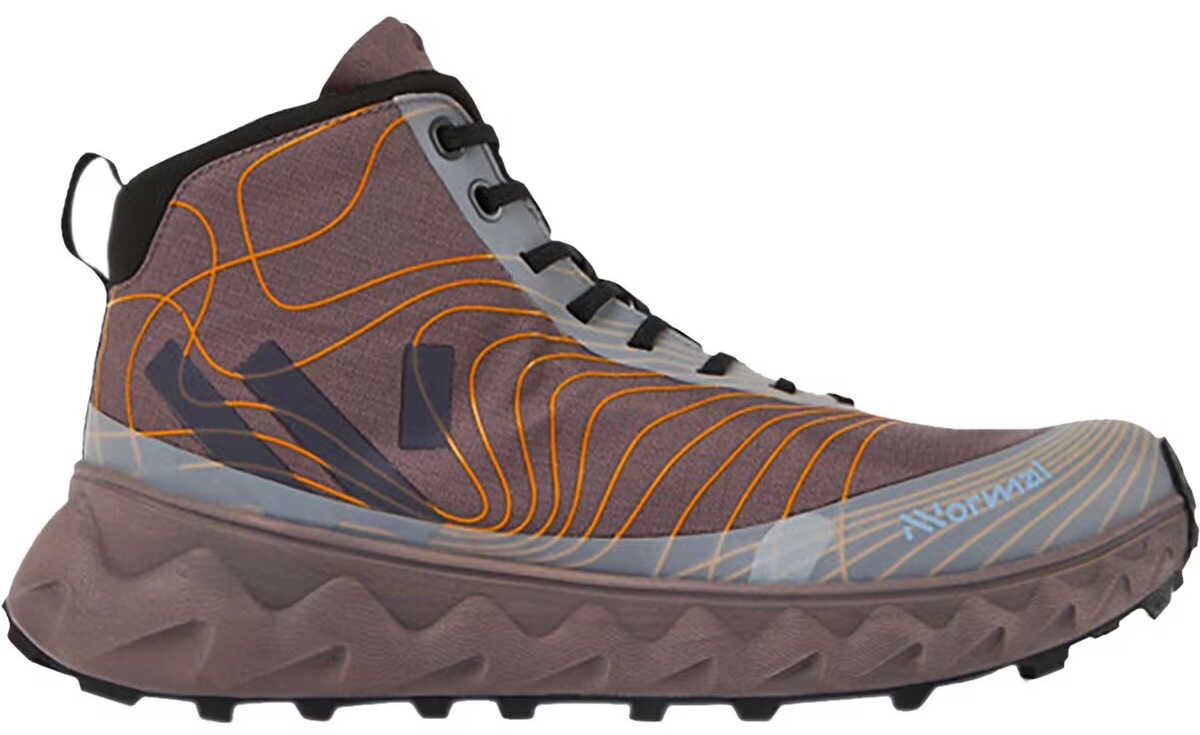 Category: Lightweight
Category: Lightweight
Upper: Synthetic
Waterproofing: Sympatex
What we like: A super lightweight hiking boot with a surprising amount of stability.
What we don’t: Not a standout breather and runs a bit big.
NNormal is a relative newcomer to the hiking boot market, but they’re making quite the splash with their Tomir Waterproof Boot. Designed with legendary long distance runner Kilian Jornet, the Tomir blurs the line between hiking boot and trail runner. At just 1 pound 5.4 ounces, the Tomir is lighter weight than many of our favorite trail runners, but it boasts a surprising amount of foot and ankle support like a traditional hiking boot. In fact, we tested this boot on a technical multi-day trek in the Patagonian backcountry and were impressed with how well it tackled extremely challenging terrain. Its Sympatex waterproofing is also a boon, performing just as well as Gore-Tex in drizzly weather and through stream crossings.
It’s commonly known that waterproof boots suffer in their breathability, but we found the Tomir boots to be worse off than most. Our tester consistently sweat through her socks on the sun-exposed trails in South America. We also wish that there was a touch more underfoot cushion for protection on rocky trails. Lastly, it’s worth noting that the Tomir is a unisex boot, so you won’t find a women’s specific fit online or in stores. Our female tester did find that the Tomir ran large in her normal size, but it wasn’t so drastic as to cause discomfort or affect performance. All in all, the Tomirs have made a strong impression on us despite being in just their first iteration, and we’re excited to see what else NNormal comes up with in the hiking sphere.
Read more: NNormal Tomir Waterproof Boot review
See the NNormal Tomir Waterproof Boot
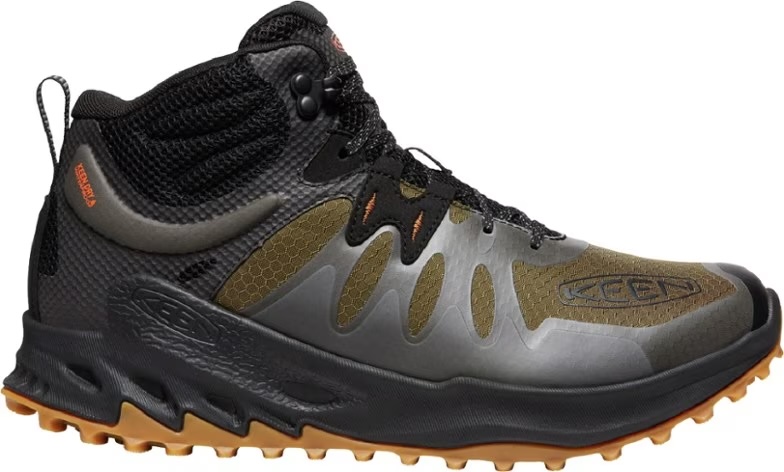 Category: Lightweight
Category: Lightweight
Upper: Synthetic
Waterproofing: Keen.Dry
What we like: Another lightweight and athletic option with great grip.
What we don’t: Too soft and prone to damage for dedicated backcountry use.
Keen’s Zionic Waterproof Mid is a cousin to the Tomir above, but unlike NNormal, Keen’s been in the hiking footwear business long enough to understand what goes into a good boot. That said, the Zionic is decidedly more athletic than Keen’s normal bulky boot style—for reference, check out the Targhee IV below—and we’ve come to enjoy its playful personality on day hikes and light backpacking trips. One of our favorite features is its outsole, which consists of prominent oval lugs that grip readily onto almost any surface we’ve hiked over (so far, it’s only struggled on steep, fresh snow). The Keen.Dry waterproofing has also kept our feet dry on soggy shoulder season hikes throughout Washington state.
If you’re used to Keen’s normal fit (read: roomy), the Zionic’s snug fit may throw you for a loop. The toe box is far from wide, but it’s not uncomfortable either. In fact, we found the Zionic quite enjoyable out of the box, and the modest amount of midsole cushioning was welcomed on rocky trails. That said, the Zionic won’t offer the same support as heftier Keens like the Targhee IV, and while we were able to get away with wearing them on short backpacking trips, the flexible collar and single eyelet don’t offer a ton of stability for really tricky trails. We also have concerns with the durability of this boot—after about 100 miles of use, they’re showing significant wear along the toe and scuffing on the exposed foam. For just $15 more, the Salomon X Ultra 5 is much more durable, and we’d recommend them over the Zionic for heavy use.
Read more: Keen Zionic Waterproof Mid review (women's version)
See the Men's Keen Zionic Waterproof Mid See the Women's Keen Zionic Waterproof Mid
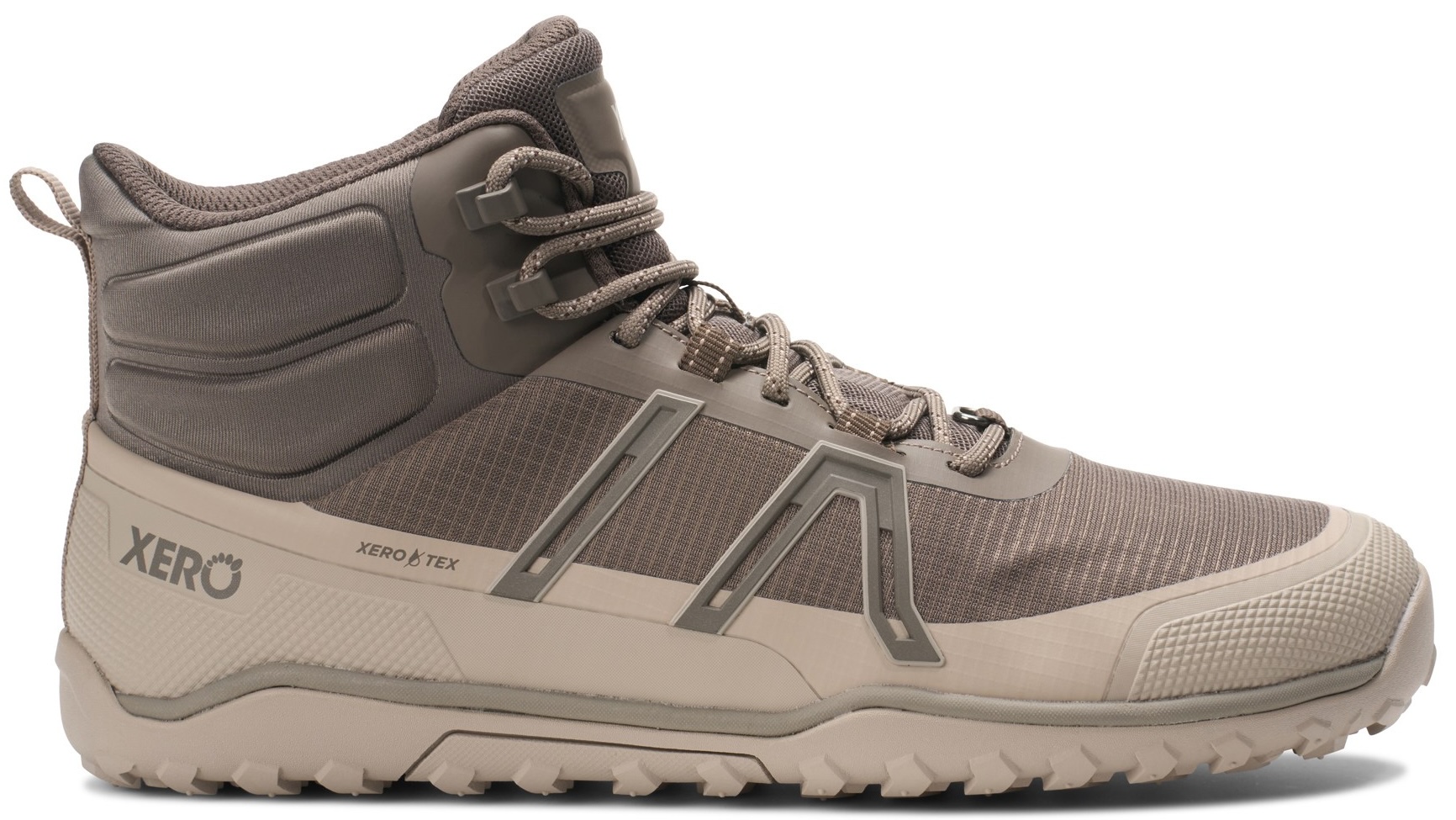 Category: Lightweight
Category: Lightweight
Upper: Textile
Waterproofing: XeroTex
What we like: A barefoot shoe with mild comfort touches, such as a toe band and gusseted tongue.
What we don’t: Doesn’t offer the support, cushion, or rockered profile of an efficient long-distance hiker.
If the Altra above isn’t all-natural enough for you, Xero’s Scrambler Trail Mid might be the barefoot shoe you’re looking for. Right off the bat, we’ll say that we don’t use the term “barefoot” lightly here: With zero drop and a minimal EVA midsole, you’ll be sure to feel every stone and root you step on in this kicks. But they also boast a comfortably snug sock-like fit and a supple construction (you can literally bend this shoe in your hands). The upper extends to the ankle and the dual hooks allowed us to cinch these boots tight for a surprising amount of support. The materials and tread have all proven durable so far, and we’ve had lots of luck with the XeroTex waterproofing while wearing these on an early-season backpacking trip to Ross Lake in Washington state. The gusseted tongue is an especially thoughtful touch point, providing an extra bit of assurance when hiking through deep creeks.
There are lots of comforts you give up in going with a proper barefoot shoe, the main ones being protection and support. While the Scrambler Mids have more ankle support than we initially assumed they would, the upper isn’t stiff enough to support a heavy load unless you've really trained your feet for it. What’s more, the thinner materials leave your feet more susceptible to trail injury, be that from accidentally kicking a rock or general foot fatigue. The flat profile doesn’t help with momentum, either, and we found it tough to battle up steep trails or move efficiently through flat terrain without a bit of rocker. That said, Xero pulls off the barefoot profile better than most, and they include enough protective features—such as a thin rubber toe rand—to lend some comfort to the true barefoot experience. Like the Altras above, we recommend getting used to these boots on easy hikes if you’re not practiced with barefoot shoes already, but if you’re curious about the hype, the Scrambler Mids are a safe way to dip your toes into the water.
See the Men's Xero Scrambler Trail Mid WP See the Women's Xero Scrambler Trail Mid WP
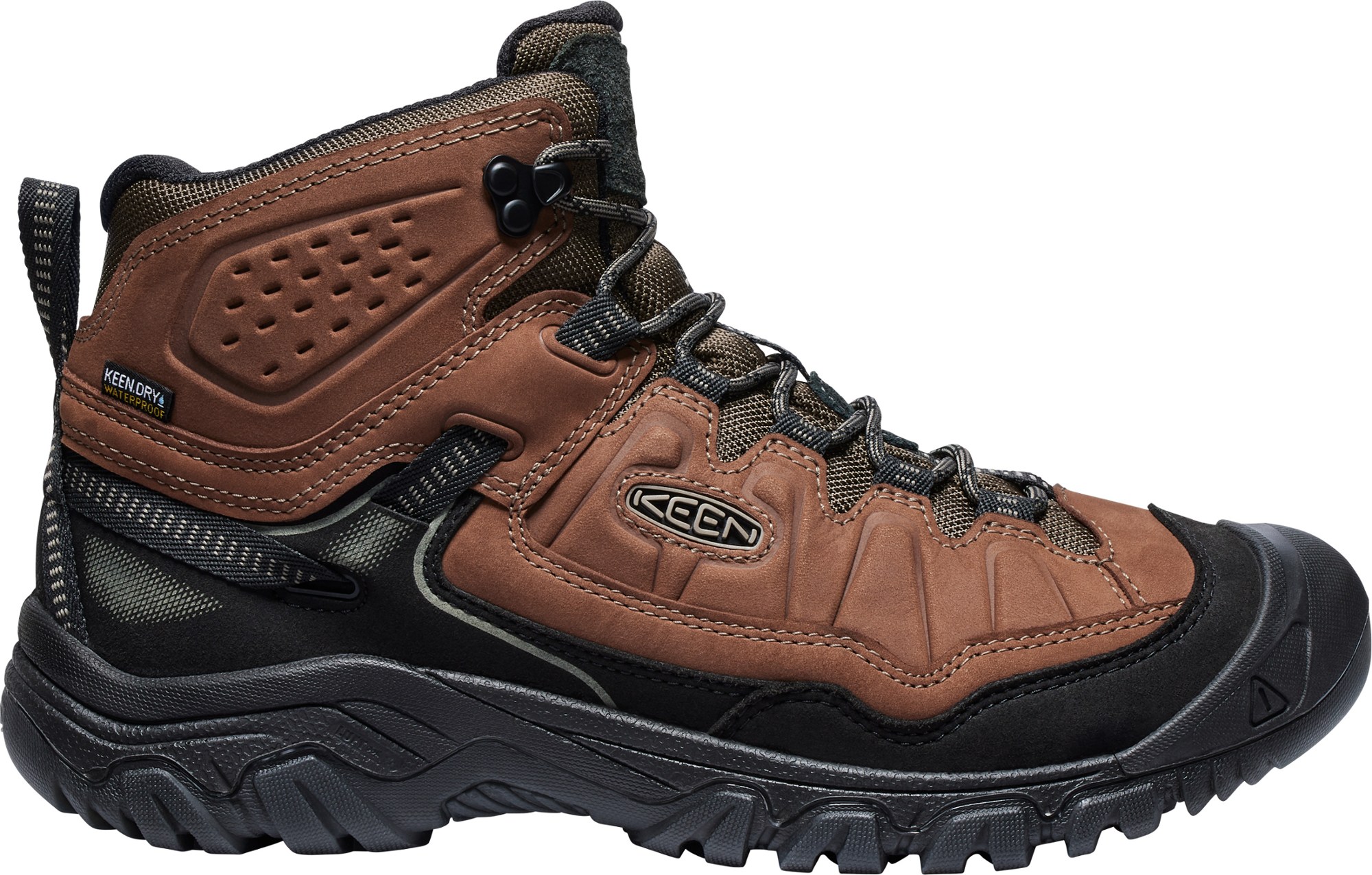 Category: Midweight
Category: Midweight
Upper: Leather
Waterproofing: Keen.Dry
What we like: A durability-first hiking boot that’s highly supportive too.
What we don’t: Loose fit and hefty construction can be sloppy on the trail; tread has let us down.
It's likely when you think of a traditional leather hiking boot that Keen’s Targhee comes to mind. The latest IV aims to be the most durable hiking boot on the market, and while we have yet to push our pair far enough to test that claim, Keen renewed this classic design with some compelling features that might get it close. Most notably, the Targhee IV addresses the issue of delamination (when the midsole breaks down from moisture exposure) by swapping to a glue-free construction that fuses the parts of the boot together. The lack of environment-harming solvents also gives the IV a strong sustainability slant, and the use of post-consumer plastics and Leather Working Group- certified leather round it out well.
The Targhee IV is just as burly and supportive as it looks, and its sturdy construction is ready to take on long and gear-heavy missions. Like the Keen Zionic above, the Targhee IV is outfitted with Keen.Dry waterproofing that rolls water right off the boot’s leather. Where the boot starts to falter is traction: The outsole of this latest model isn’t as grippy as the Zionic’s round lugs, and we found ourselves sliding around on damp rocks in recent testing. The boot also has a generous fit which nicely accommodates swelling feet, but can also feel sloppy on the trail (the hefty weight and simple lacing system don’t help). Lastly, the rugged construction takes a while to break in, and the stiff upper can lead to some ankle soreness in the process. But that’s the price you pay for durability, and we don’t doubt the Targhee IVs will last for many seasons of heavy use.
Read more: Keen Targhee IV review (women's version)
See the Men's Keen Targhee IV WP See the Women's Keen Targhee IV WP
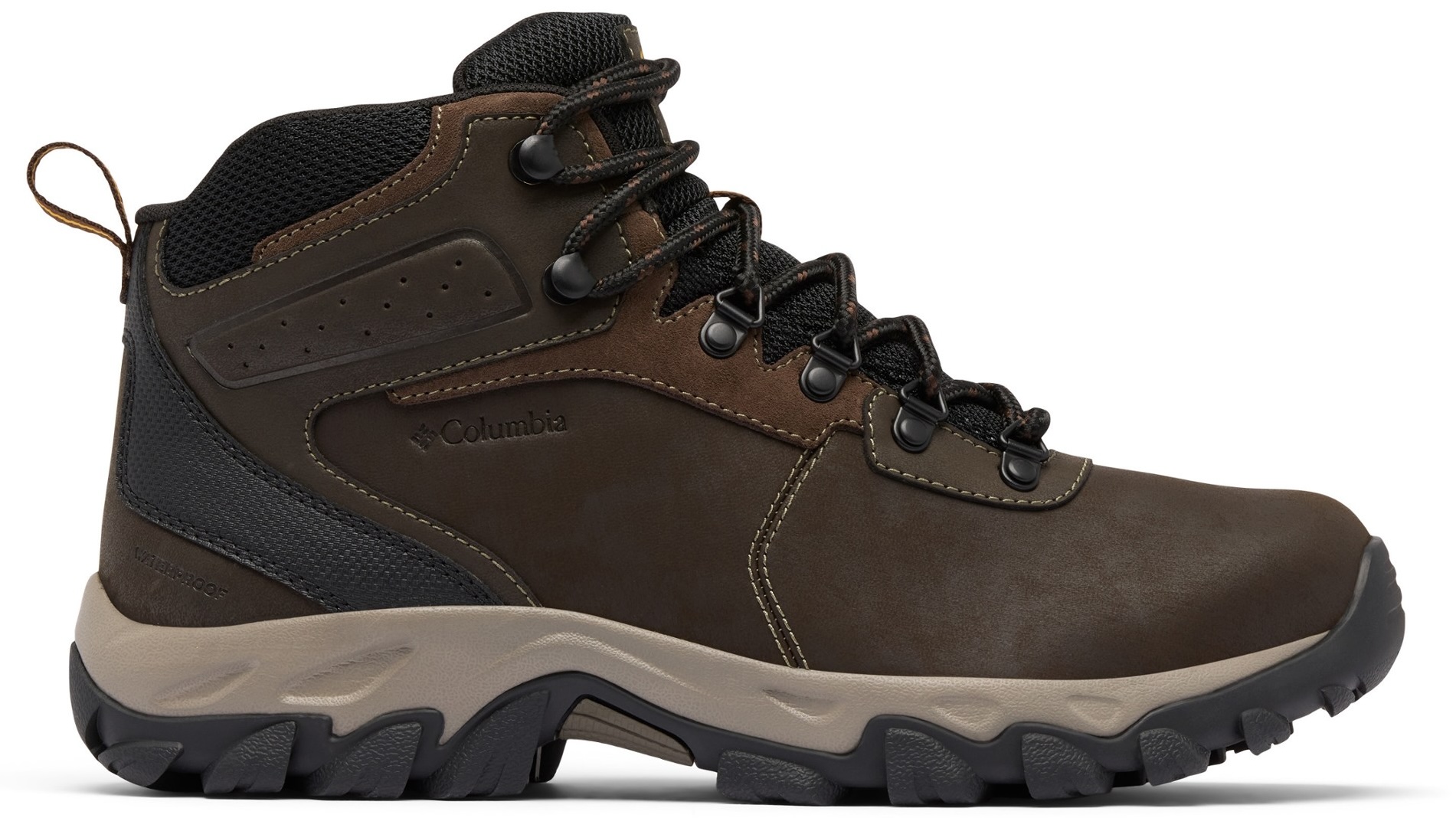 Category: Light/midweight
Category: Light/midweight
Upper: Leather
Waterproofing: Omni-Tech
What we like: Comfortable with reliable waterproofing for just $100.
What we don’t: Not the most durable or supportive.
Columbia’s Newton Ridge Plus (and the men’s Plus II) surprised us with their comfort and performance over the last few months of testing. In fact, we found ourselves grabbing them over any other boots for casual day hikes. The generous toe box and lightweight foam midsole are supremely comfortable, even right out of the box. And Columbia’s Omni-Tech waterproofing kept our feet surprisingly dry when hiking ten miles in a rare sea-level snowstorm in Bellingham, WA. With a semi-stiff collar and dual hooks for lacing up the ankle, the Newton Ridge provides enough support for most steep trails. Best of all, this boot is available for just $100, saving you $50 over the Merrell Moab 3 above.
However, there’s a reason our Best Budget designation goes to the Merrell: it balances cost-efficiency and material quality a bit better than the Columbia. In many ways, the Newton Ridge is decidedly budget. The tread, while decent on most terrain, struggles in mud and loose dirt—our pair is already showing signs of wear along the toe, and the collar has a habit of buckling on off-camber trails, leading to wobbly ankles. We took these boots out on a backpacking trip in dusty eastern Washington and had some serious foot fatigue after just nine miles with a heavy pack. But for $100, we feel we can’t be too harsh. Lastly, it’s worth pointing out the difference between the men’s Plus II and women’s Plus: The Plus II features a polyurethane-coated leather upper (which gives them a boost in durability and weather resistance), and the Plus does not. We’ve only had a chance to test the women’s version so far, but we don’t expect this discrepancy to yield a major performance difference between the two.
See the Men's Columbia Newton Ridge Plus II See the Women's Columbia Newton Ridge Plus
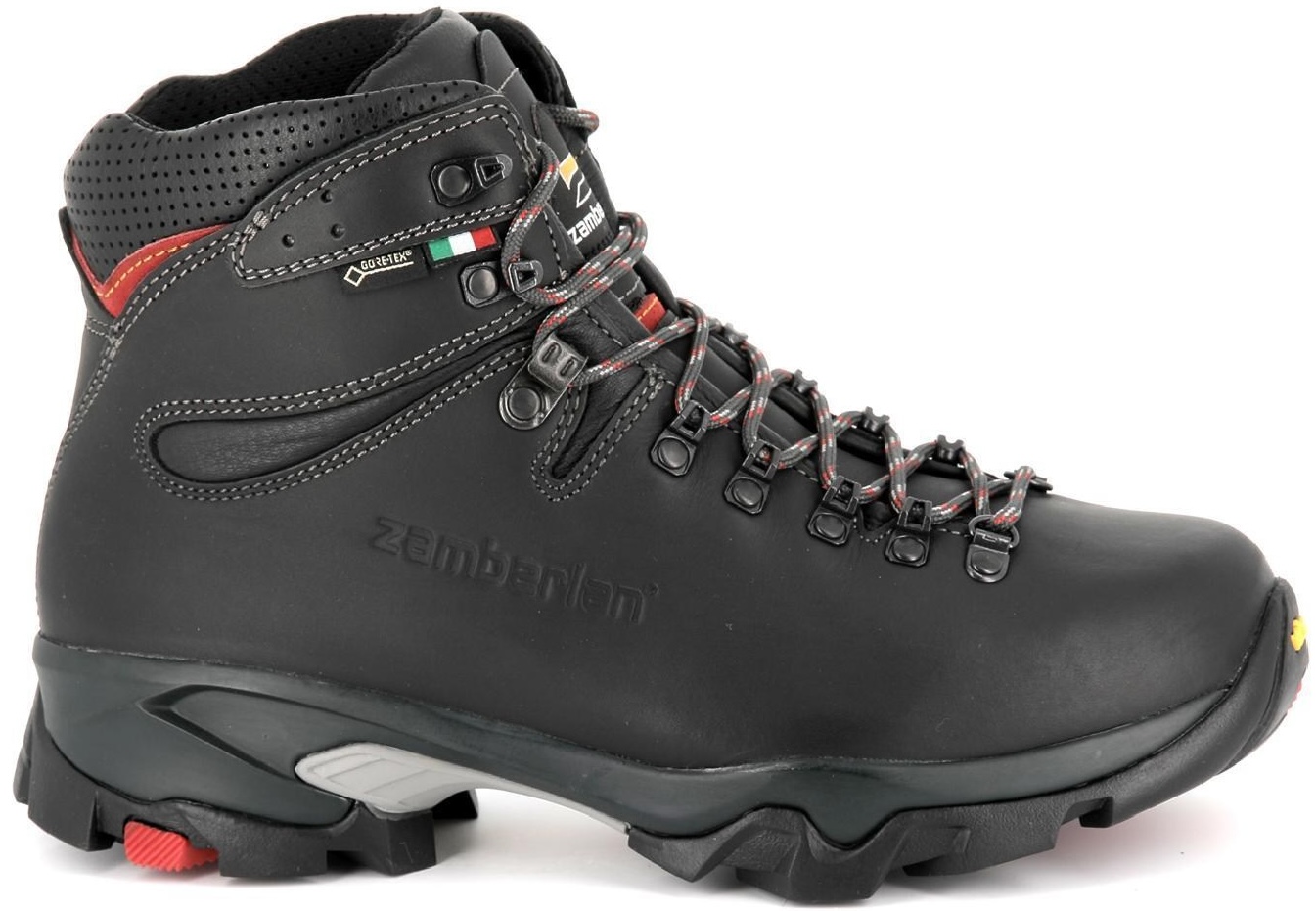 Category: Lightweight
Category: Lightweight
Upper: Full grain leather
Waterproofing: Gore-Tex
What we like: A heavyweight hiking boot for heavyweight backpacking trips.
What we don’t: Overkill for casual backpackers and day hikes.
Heavy leather clunkers of yore have been readily replaced by lightweight and streamlined hiking boots—even Keen has acquiesced to the athletic market with their Zionic lineup—but there are situations in which it's simply best to have tough and heavy footwear. Think rough trails with heavy weight on your back or light mountaineering objectives. Existing in the space between hiking and mountaineering boots is Zamberlan’s Vioz GTX, a well-made full-grain leather boot with a stiff structure, confidence-inspiring Vibram tread, and premium Gore-Tex waterproofing. The tough leather exterior is balanced nicely with a soft interior and shock-absorbing polyurethane midsole. The boot is somewhat a piece of art—and its hefty $350 price tag confirms it—but it's built to handle most anything that serious backpackers throw at it.
So why is the Vioz at the bottom of our list? Simply put, it’s too much boot for most situations. Its heavy weight (over three pounds for the men’s version) makes it tough to cover ground efficiently. Most backpackers will be better off sticking with midweight boots, like the Salomon Quest above, and day hikers or fast packers will certainly lean lightweight. That said, we have to give it to Zamberlan for sticking to tradition and durability. And if you happen to wear through your Vioz, the brand offers resoling and repair programs through their site.
See the Men's Zamberlan Vioz GTX See the Women's Zamberlan Vioz GTX
| Boot | Price | Category | Weight | Waterproofing | Upper |
|---|---|---|---|---|---|
| Salomon X Ultra 5 Mid Gore-Tex | $185 | Lightweight | 1 lb. 15.0 oz. | Gore-Tex | Leather / textile |
| Merrell Moab 3 Mid WP | $150 | Light/mid | 2 lb. 2.9 oz. | Merrell Select | Leather / mesh |
| Salomon Quest 4 GTX | $230 | Mid/heavy | 2 lb. 14.2 oz. | Gore-Tex | Leather / textile |
| Altra Lone Peak 9 WP Mid | $180 | Lightweight | 1 lb. 15.9 oz. | Cosmo lining | Mesh |
| Scarpa Rush Mid 2 GTX | $219 | Lightweight | 1 lb. 13.2 oz. | Gore-Tex | Mesh / synthetic |
| Hoka Anacapa 2 Mid GTX | $195 | Midweight | 2 lb. 4.0 oz. | Gore-Tex | Leather / mesh |
| Lowa Renegade Evo GTX Mid | $265 | Midweight | 2 lb. 9.6 oz. | Gore-Tex | Nubuck leather |
| La Sportiva TX Hike Mid Leather | $219 | Light/mid | 1 lb. 15.0 oz. | Gore-Tex | Leather |
| Topo Athletic Trailventure 2 | $185 | Light/mid | 1 lb. 15.8 oz. | eVent | Synthetic |
| Teva Grandview GTX Mid | $175 | Light/mid | 2 lb. 2.0 oz. | Gore-Tex | Leather / mesh |
| NNormal Tomir Waterproof | $195 | Lightweight | 1 lb. 5.4 oz. | Sympatex | Synthetic |
| Keen Zionic Waterproof Mid | $170 | Lightweight | 1 lb. 12.9 oz. | Keen.Dry | Synthetic |
| Xero Scrambler Trail Mid WP | $160 | Lightweight | 1 lb. 7.2 oz. | XeroTex | Textile |
| Keen Targhee IV Waterproof | $180 | Midweight | 2 lb. 8.7 oz. | Keen.Dry | Nubuck leather |
| Columbia Newton Ridge Plus II | $100 | Light/mid | 1 lb. 15.9 oz. | Omni-Tech | Leather |
| Zamberlan Vioz GTX | $350 | Heavyweight | 3 lb. 2.4 oz. | Gore-Tex | Full Grain Leather |
| Boot | Price | Category | Weight | Waterproofing | Upper |
|---|---|---|---|---|---|
| Salomon X Ultra 5 Mid Gore-Tex | $185 | Lightweight | 1 lb. 11.5 oz. | Gore-Tex | Leather / textile |
| Merrell Moab 3 Mid WP | $150 | Light/mid | 1 lb. 11.1 oz. | Merrell Select | Leather / mesh |
| Salomon Quest 4 GTX | $230 | Mid/heavy | 2 lb. 5.7 oz. | Gore-Tex | Leather / textile |
| Altra Lone Peak 9 WP Mid | $180 | Lightweight | 1 lb. 10.9 oz. | Cosmo lining | Mesh |
| Scarpa Rush Mid 2 GTX | $219 | Lightweight | 1 lb. 8.3 oz. | Gore-Tex | Mesh / synthetic |
| Hoka Anacapa 2 Mid GTX | $195 | Midweight | 1 lb. 13.4 oz. | Gore-Tex | Leather / mesh |
| Lowa Renegade Evo GTX Mid | $265 | Midweight | 2 lb. 2.2 oz. | Gore-Tex | Nubuck leather |
| La Sportiva TX Hike Mid Leather | $219 | Light/mid | 1 lb. 12.6 oz. | Gore-Tex | Leather |
| Topo Athletic Trailventure 2 | $185 | Light/mid | 1 lb. 10.2 oz. | eVent | Synthetic |
| Teva Grandview GTX Mid | $175 | Light/mid | 1lb. 11.0 oz. | Gore-Tex | Leather / mesh |
| NNormal Tomir Waterproof | $195 | Lightweight | 1 lb. 5.4 oz. | Sympatex | Synthetic |
| Keen Zionic Waterproof Mid | $170 | Lightweight | 1 lb. 8.6 oz. | Keen.Dry | Synthetic |
| Xero Scrambler Trail Mid WP | $160 | Lightweight | 1 lb. 3.4 oz. | XeroTex | Textile |
| Keen Targhee IV Waterproof | $180 | Midweight | 2 lb. 1.2 oz. | Keen.Dry | Nubuck leather |
| Columbia Newton Ridge Plus | $100 | Light/mid | 1 lb. 10.8 oz. | Omni-Tech | Leather |
| Zamberlan Vioz GTX | $350 | Heavyweight | 2 lb. 13.2 oz. | Gore-Tex | Full Grain Leather |
If you’re anything like us, wet conditions aren’t quick to dampen our enthusiasm for hitting the trails, and we turn to waterproof hiking boots as the key to enjoying the outdoors regardless of the weather. In that way, testing waterproof hiking boots has happened quite naturally over many years, and we’ve packed hundred miles into our favorite models. While our attention is, of course, focused on how dry our socks stay when wearing these boots, we’re also sure to consider other important factors, such as their stability, comfort, and protection. We test lightweight models on fast-packing treks, taking note of their agility and breathability (as much as a waterproof boot can be), and we save demanding backpacking missions for testing hefty leather stompers, sussing out their ankle and foot support under heavy weight. Durability is always on our radar, and we’re sure to note where our boots show any sign of wear after significant use on the trail.
Former editor-in-chief John Ellings curated our initial list of the best hiking boots (both waterproof and non) back in 2015, and editor Maddie Downie narrowed the list down here to include those with outstanding waterproofing. As an avid backpacker and hiker, Maddie, of course, participated in plenty of her own testing, and living in Bellingham, Washington—which sees 150 days of rain a year on average—means she can often start testing right out her front door. We also rely on feedback from our team of testers, and are always communicating with the greater hiking community to get their opinions on the market. We know that waterproof hiking boot options are always changing, so we’ve slotted this guide into regular updates throughout the year so the list stays up to date.
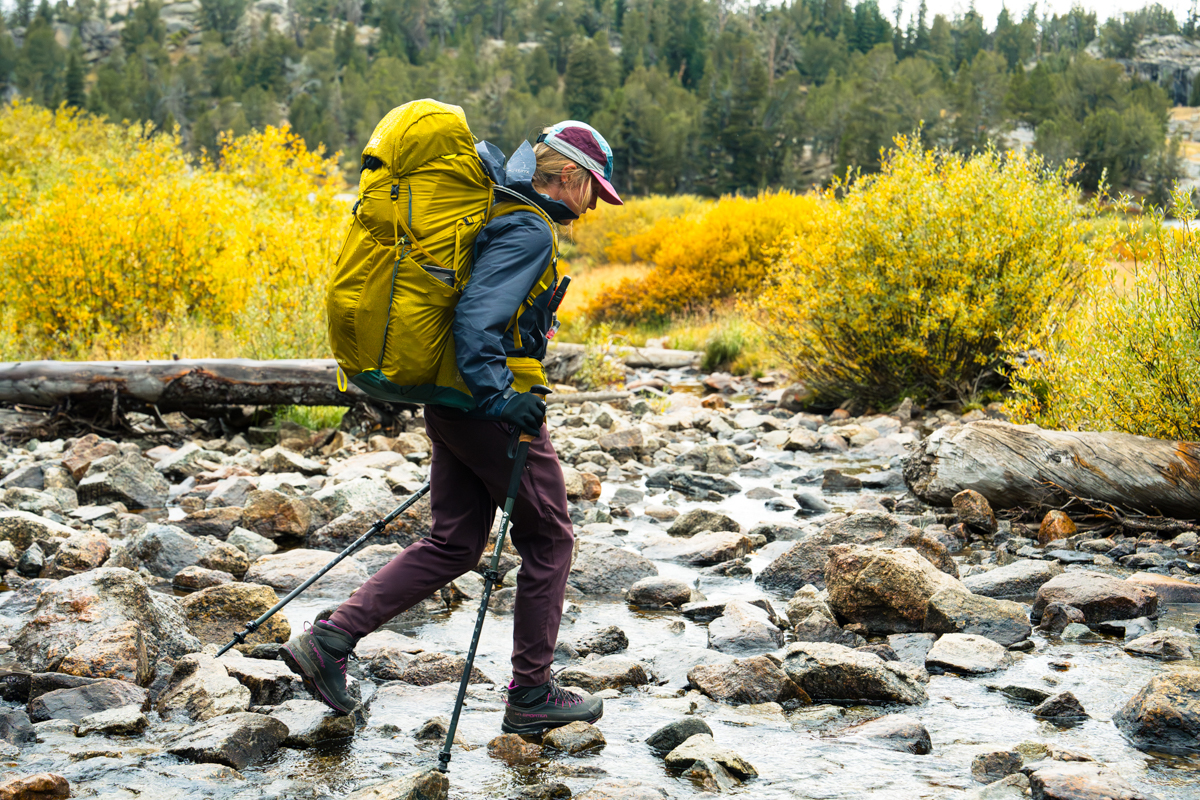
For most hikers, waterproofing is a must-have—and with good reason. The security of staying dry during a surprise downpour on a backpacking trip is enough for many to reach for a waterproof model. Most waterproof hiking boots feature a breathable bootie-style liner tucked inside the outer fabric to block moisture while still allowing some airflow. Gore-Tex is the most widely known and trusted name in the business, but don’t overlook in-house technologies like Keen.Dry or Topo Athletic's eVent. While performance is often comparable when it comes to waterproofing, breathability and consistency can vary from brand to brand. To round things out, these boots also have a durable water repellent (DWR) coating to help water bead off the surface instead of soaking in.
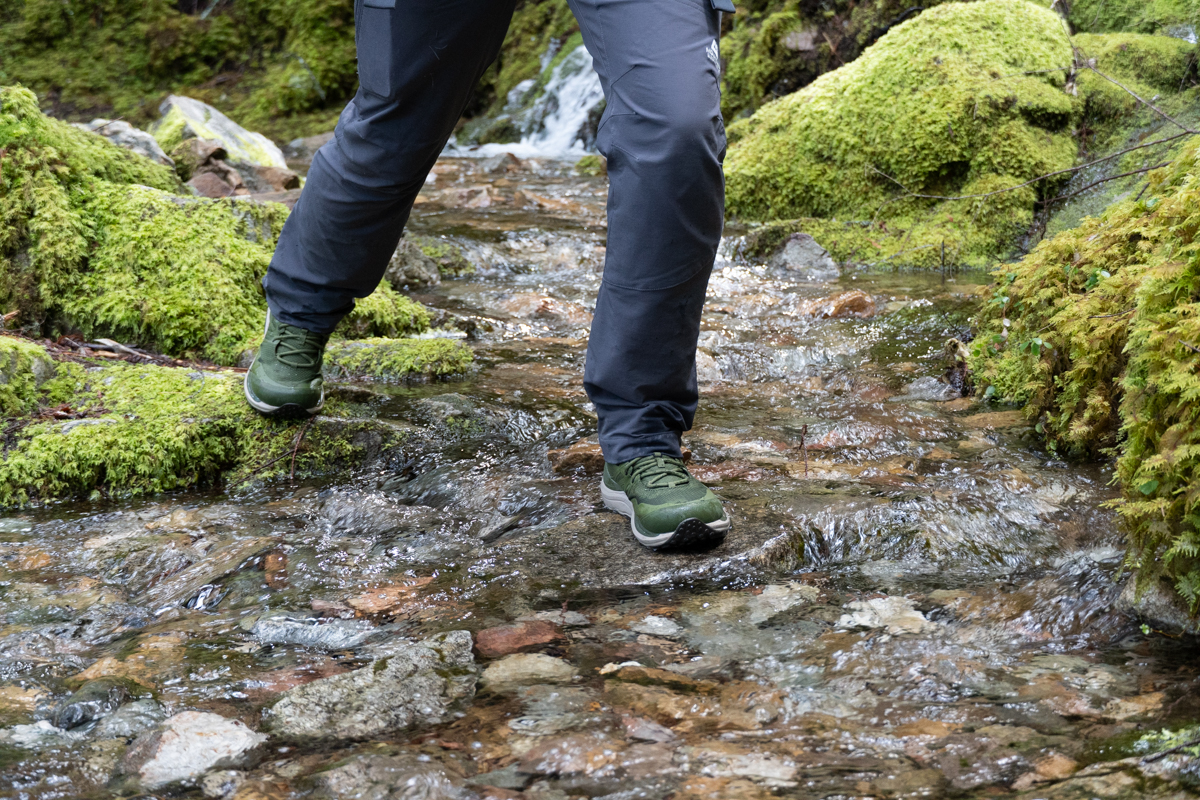
That said, just because most hiking boots are waterproof doesn’t mean that all of them should be. Waterproofing is great for stream crossings, mud puddles, and spring runoff—but in hot, dry climates or on sweaty summer days, it can backfire. On a mid-July trip to Utah, for instance, a waterproof liner might turn your boots into a portable sauna. Plus, in truly soaked conditions, even the best waterproof membrane can eventually give out. That’s why some seasoned hikers and backpackers prefer non-waterproof boots paired with gaiters. While this setup won’t block out all water, it does dry out much faster and helps block debris and splashes from entering over the top of your boot.
Ultimately, we think waterproofing is still the best choice for most folks, especially those heading into mountainous terrain where rain, snow, or water crossings are common. A quality waterproof liner will keep you relatively dry even in foul weather, and it adds a bit of insulation during shoulder-season outings. But if you frequent desert environments like Arizona or southern Utah, a non-waterproof model is likely the smarter—and cooler—choice. Unfortunately, most boots don’t offer both versions, but a few do, such as the Merrell Moab 3. For more on this topic, check out our full hiking boots guide for a mix of waterproof and non-waterproof options.
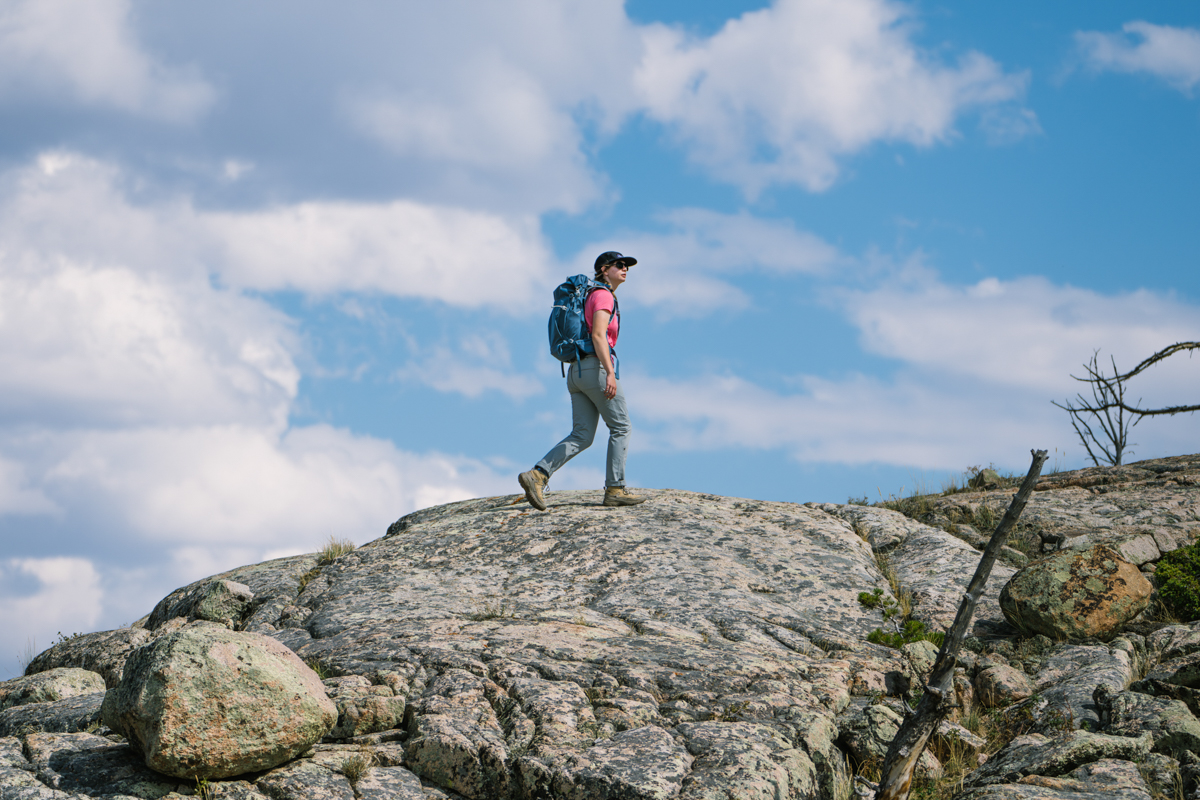
Claiming a waterproof boot is “breathable”—as marketers often do—is somewhat of a misnomer. There’s no way around it—restricting water from entering also restricts sweat and heat from easily escaping. This means that waterproof boots, no matter how advanced, can feel stuffy in the warmer months. Still, breathability levels vary significantly across designs. Heavy-duty leather boots with waterproof membranes tend to be the least breathable, like Zamberlan’s beefy Viox GTX. Midweight options like the Lowa Renegade Evo or Salomon Quest 4 strike a balance, combining nylon and leather with Gore-Tex liners that perform well enough even on summer backpacking trips. For the best ventilation, look for lightweight models with mesh panels in the upper. Designs like the Keen Zionic Waterproof Mid or Teva Grandview GTX Mid breathe well enough to wear year-round and still manage to keep water at bay when needed.

Lightweight
Lightweight hiking boots are all about speed and flexibility. They’re nimble enough for day hikes and short backpacking trips, yet still offer more support than a trail running shoe. NNormal's Tomir pulls this off better than most, but other lightweight boots like the Keen Zionic Mids and Scarpa Rush 2 GTX land in this category. Most use affordable waterproof liners (usually not Gore-Tex), and rely on mesh and nylon to cut weight and cost. You’ll sacrifice some durability and structure, but for most day hikes or light loads, they perform admirably.
There’s also a growing crossover category of mid-height trail runners. Popular shoes like the Altra Lone Peak and Hoka Speedgoat are now available with extended collars for ankle support. These “hiker” versions of trail running shoes retain their cushy, energetic ride but gain a bit of protection and support. The trade-offs? Less durability, minimal toe protection, and limited support when carrying a heavy pack or navigating rough trails. But those who like to move fast and light and even mix in some running during their adventures may find that the pros of a nimble boot like Altra’s Lone Peak 9 Waterproof Mid above outweigh the cons.
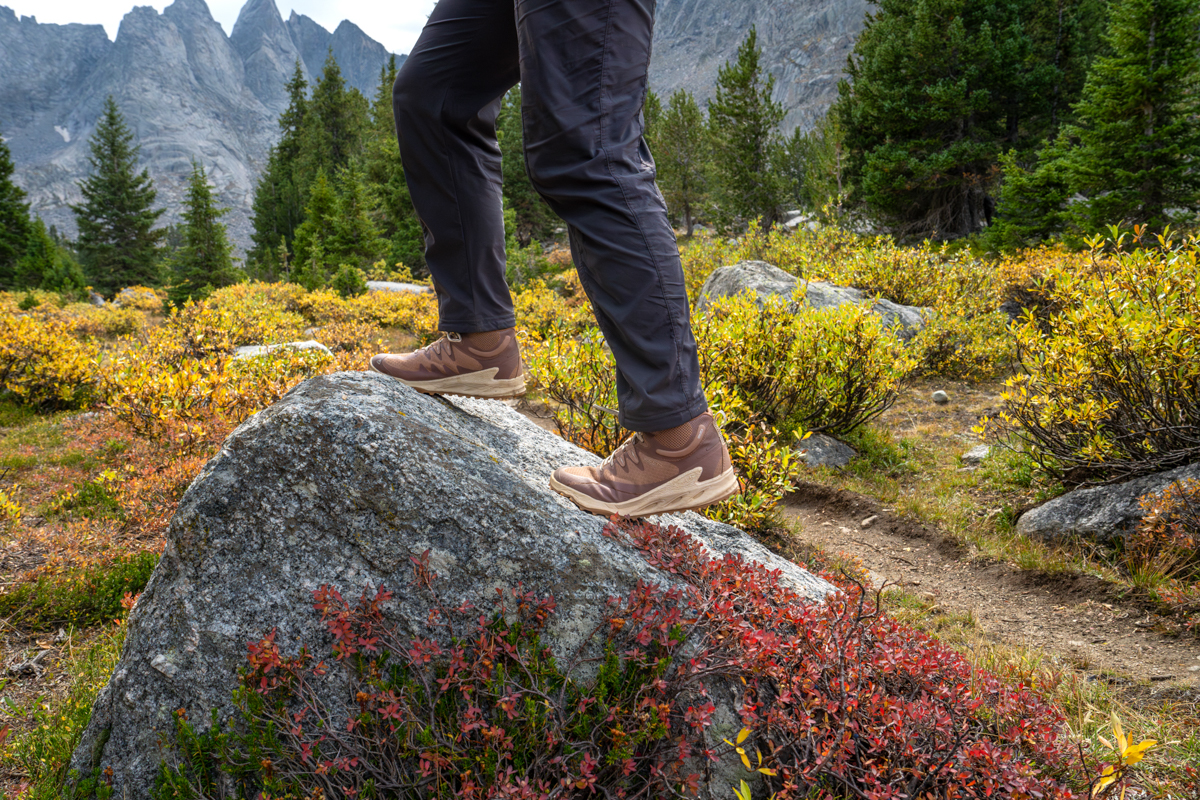
Midweight
Midweight boots sit at the sweet spot: substantial enough to carry a heavy load, but not so bulky that they slow you down. This growing category includes models like the Keen Targhee IV and Lowa Renegade Evo GTX. You’ll get excellent support and decent stiffness underfoot without the tank-like feel of a heavier boot. Construction quality also steps up here, with premium waterproof liners like Gore-Tex becoming standard. Expect prices to start around $200, but you’ll get a significant boost in comfort and longevity.
Heavyweight
In general, we're seeing the market move away from heavyweight stompers as athletic models become more popular, but if you're venturing into rugged terrain with a full pack or planning cold-weather adventures, a heavyweight boot is worth considering. These stiff, rugged designs are made to withstand abuse. Their thick leather or synthetic uppers paired with Gore-Tex waterproofing make them ideal for snow, rain, and rocky scrambles. And because of their structure, they help reduce fatigue on long climbs and even accommodate strap-on crampons for light mountaineering. But don’t skip the break-in process—these boots need time to mold to your feet before a big trip. From our lineup, Zamberlan's Viox GTX is the only true heavyweight model we include, but some of the heavier midweight models, such as the Salomon Quest 4 GTX, toe the line between the two categories.
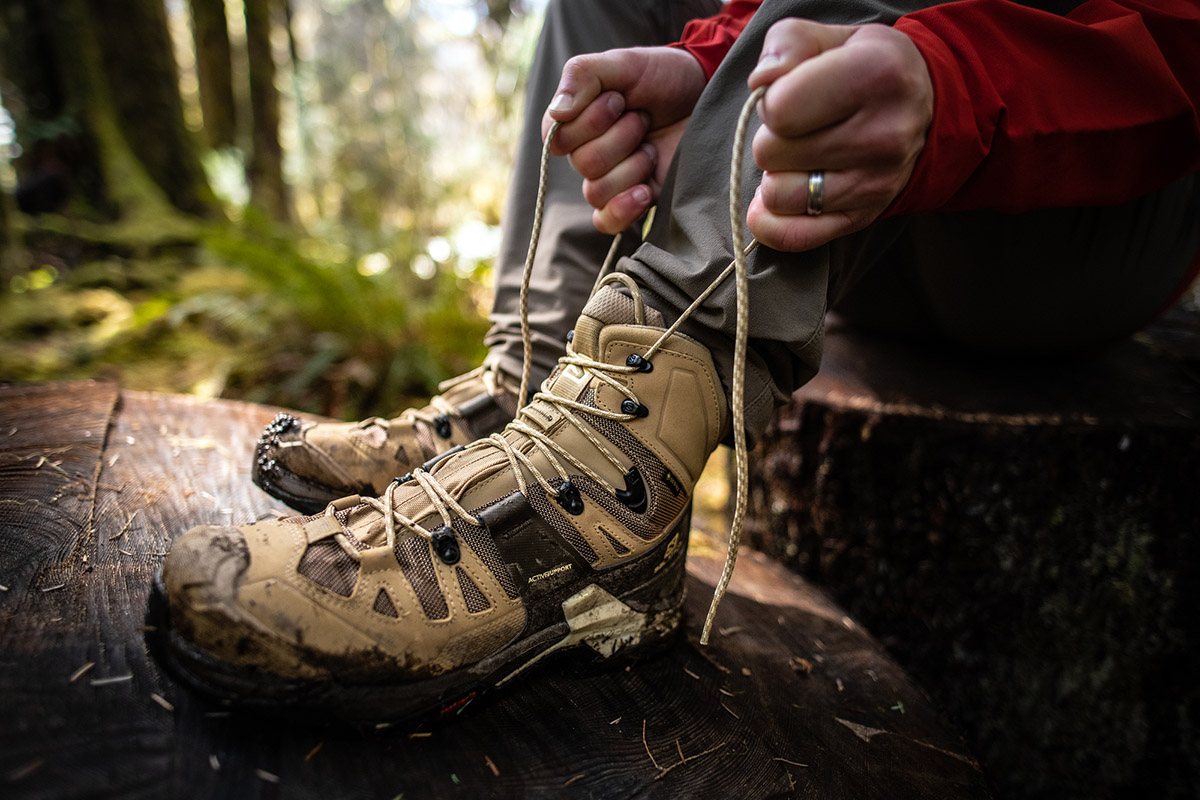
Weight is a big factor in performance and comfort. Hiking boots run the gamut: ultralight designs like the NNormal Tomir can weigh as little as a pound and a half for the pair, while burly, supportive models can exceed 3 pounds (such as the Zamberlan Vioz). Generally speaking, lighter boots are less protective and supportive, and may not hold up as well over time. This can be a problem if you're hauling a heavy backpack over long distances, but for fastpacking, thru-hiking, or warm-weather trips with a light load, the reduced weight can make a big difference in comfort and speed.
Our philosophy? Use the lightest boot that still meets your needs. For some adventures, that might mean a trail runner-inspired hiker. For others—like hauling gear through rocky terrain or hiking in extreme weather—you’ll need the confidence and protection of a heavier model. One of the best do-it-all options is the Salomon Quest 4 GTX, which strikes a superb balance between weight and ruggedness.

Stability is a core function of a hiking boot, and much of it comes from a hidden hero: the shank. This stiff plastic insert sits between the midsole and outsole, running partially or fully underfoot, depending on the boot. It prevents your heel from dropping too far on ascents, reducing calf fatigue and boosting overall control. More technical boots have longer, stiffer shanks, such as those in full-shank mountaineering boots. On the other hand, many lightweight boots forego shanks for more flexibility and comfort and instead rely on tall uppers for ankle support.
For easy trails and quick day hikes, a light, pliable boot like the Altra Lone Peak 9 Waterproof Mid or Keen Zionic Waterproof Mid is more than sufficient. All-natural aficionados might even enjoy the decidedly minimalist barefoot shoe, like Xero's Scrambler Trail Mid WP. But for extended treks or when you’re carrying a heavy pack, the added ankle and foot support of a sturdier boot—like the Lowa Renegade Evo or Keen Targhee IV—is well worth it. And if you plan to go off-trail, cross scree fields, or tackle exposed sections, heavyweight boots such as the Salomon Quest 4 offer unbeatable protection and support.

Laces might not be flashy, but they play a huge role in how a boot fits and feels. A poor lacing system that loosens easily can lead to hot spots, blisters, or constant trail-side adjustments. Sometimes, it's just the laces themselves—an easy fix with aftermarket replacements—but more often, it’s the hardware or layout. We’re not big fans of single-pull systems like those found on some Salomon or Adidas models: they’re quick, but lack the fine-tuned adjustability of traditional laces, which can lead to discomfort over many miles when wearing a heavy backpack.
As you move up in boot categories, lacing systems tend to improve. Look for locking eyelets near the ankle—found on boots like the La Sportiva TX Hike Mid Leather GTX or Lowa Renegade Evo—which help keep your foot snugly in place. These also prevent your laces from loosening as you hike and reduce the risk of snags on branches or brush. We're really big fans of the lacing systems on the Salomon X Ultra 5, which feature chassis "wings" that secure the heel as the boot is pulled tight. Make sure you’re comfortable with the boot’s lacing system before hitting the trail, especially if you plan on long trips or carrying heavy loads.
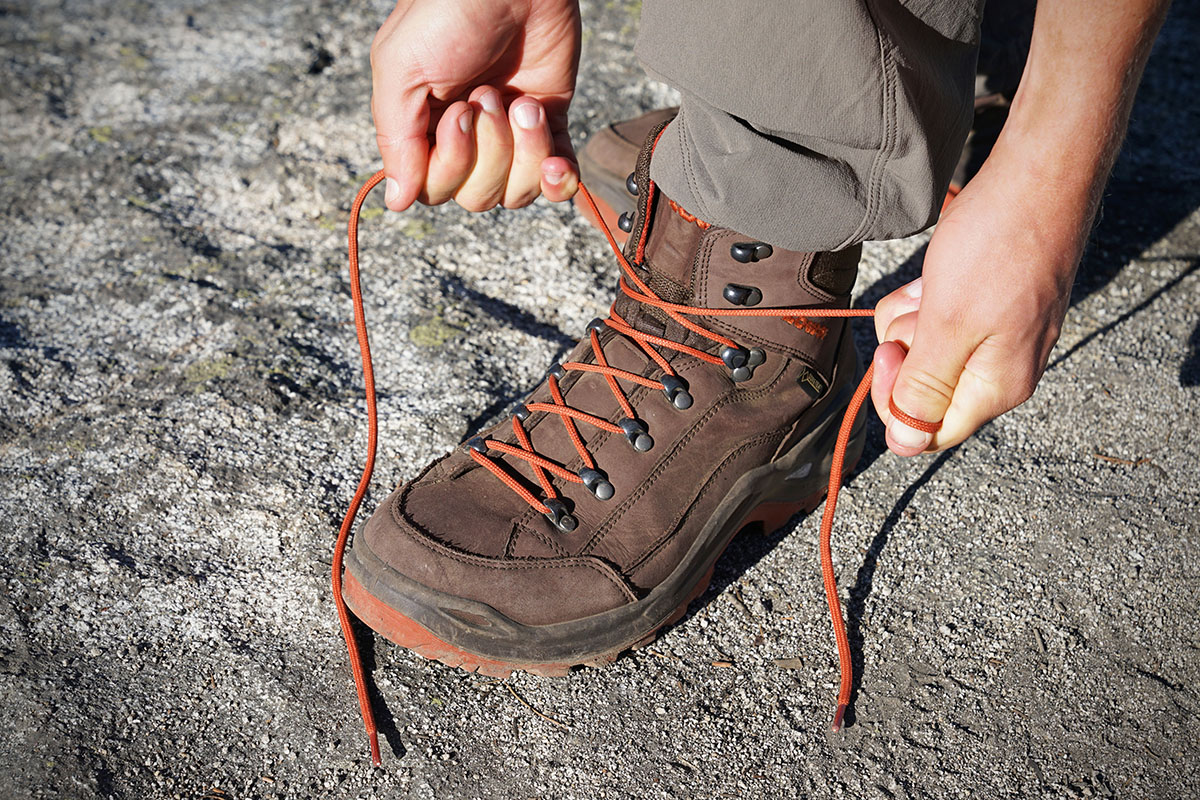
The upper is the part of the boot that connects to the sole and wraps around your foot, and the material used here plays a major role in durability, breathability, water resistance, and overall comfort. Most hiking boots use a combination of synthetic materials, mesh, and leather, though high-end models may feature full leather uppers for maximum toughness. Below is a breakdown of the most common materials and how they perform out on the trail.
Synthetic Nylon and Mesh
Synthetic nylon and open mesh panels are especially popular on lightweight and mid-range hiking boots. These fabrics offer excellent breathability and help cut down on weight—making them great for warm-weather trips or hikers prioritizing agility and speed. The trade-off, however, is durability: mesh can tear more easily and is quicker to absorb moisture. That said, there are some exceptions. The Salomon Quest 4, for instance, uses tightly woven nylon panels that rival Nubuck leather in toughness, even though they have more visible stitching. This makes them a solid compromise for hikers who want both breathability and a decent lifespan.
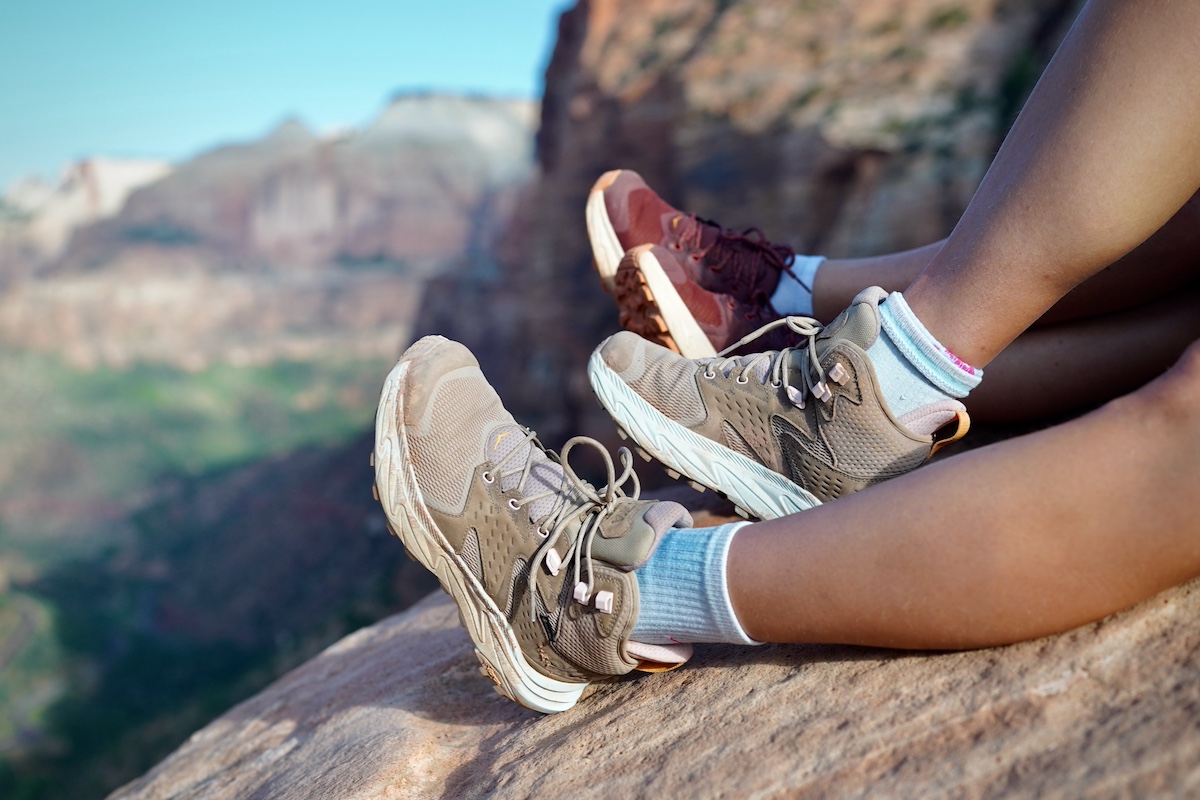
Nubuck and Suede Leather
Nubuck leather is made from full-grain leather but features a brushed finish, giving it a softer, suede-like texture. This material is a staple in mid-range hiking boots for good reason: It offers better durability than mesh while still being lighter and more flexible than traditional full-grain leather. Nubuck is also more forgiving in terms of breathability and less prone to showing wear and tear—like scuff marks—thanks to its matte finish. You’ll often see it paired with mesh in a boot's construction, where the leather adds structure and resilience in high-wear areas, such as in the Merrell Moab 3 Waterproof.
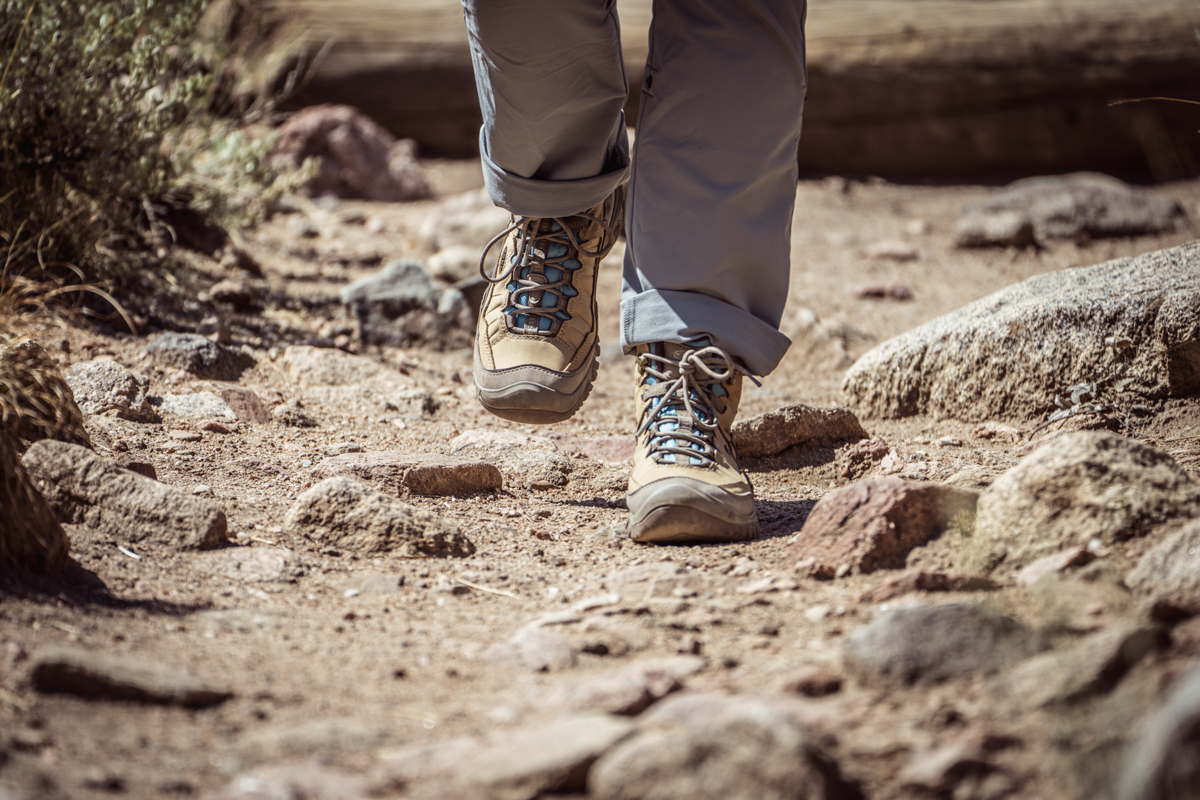
Full-Grain Leather
Full-grain leather uppers are the gold standard when it comes to toughness and water resistance. Found primarily on heavyweight and high-end hiking boots like the Zamberlan Vioz GTX, full-grain leather requires a bit more care and maintenance, but in return, it offers unmatched longevity. These boots aren't the lightest or most breathable, but if you treat them well, they’ll last for many years—often outlasting synthetic alternatives by a long shot. Bonus: some models, like Zamberlan's Vioz, are resoleable, which extends their lifespan even further.
While the outsole is your boot's tread, the midsole is its shock absorber. This layer, sandwiched between the outsole and insole, plays a key role in how your boot feels underfoot—especially when carrying a heavy load or hiking on rocky terrain. Midsoles are typically made from EVA (ethylene-vinyl acetate), PU (polyurethane), or a combination of both.
EVA
Lightweight hiking boots often use EVA foam in their midsoles, and for good reason. It’s soft, squishy, and does a great job soaking up impact. Boots with EVA feel cushy underfoot and are great for comfort on the trail, especially for day hikes or lightweight overnighters. But not all EVA is created equal—some formulas are firmer and more durable than others. If you’re putting in long miles on rugged trails, you’ll want a boot with a firmer, higher-quality EVA compound. Cheaper or overly soft EVA midsoles can compress and break down faster, much like running shoes, which diminishes long-term support.
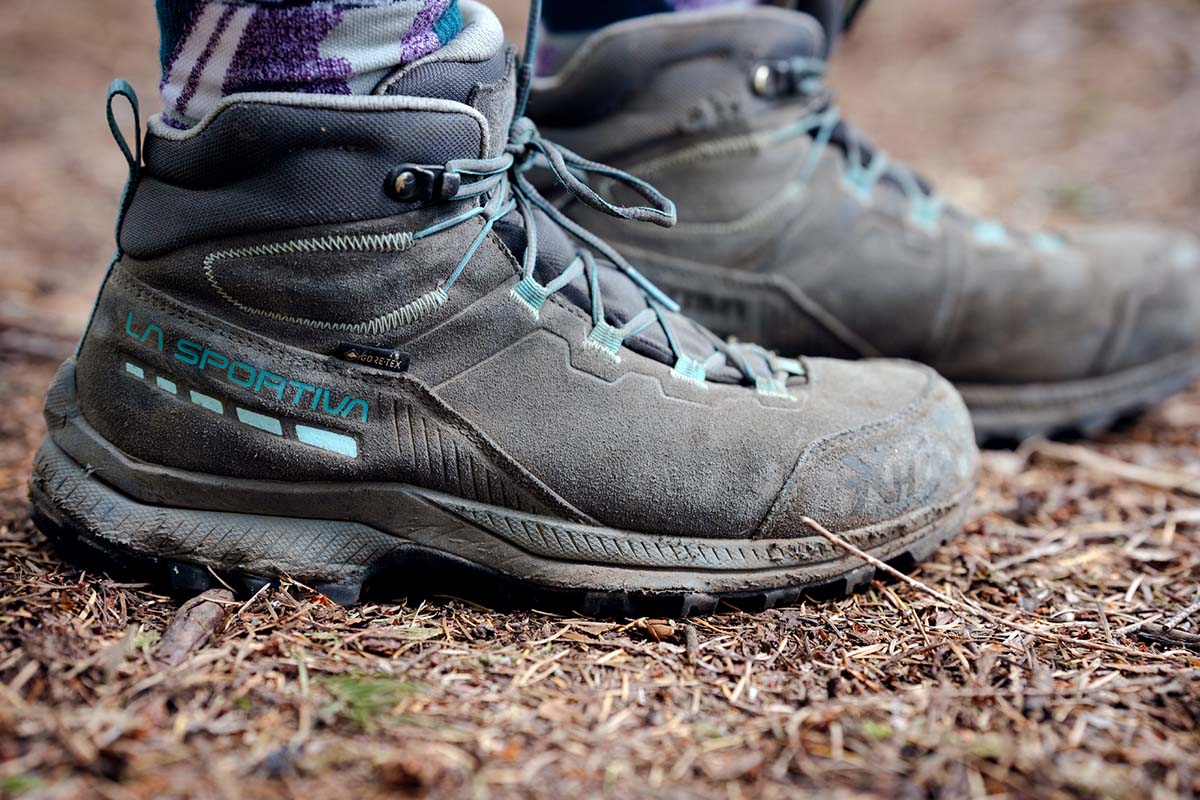
PU
For extended backpacking trips or rough, technical terrain, PU midsoles shine. Polyurethane is firmer, more supportive, and built to handle the abuse of heavy loads and tough conditions. It’s not as plush as EVA, but it’s far more durable and maintains its shape over time. You’ll find PU midsoles in boots like the Lowa Renegade Evo, and increasingly in mid-range options like the Keen Targhee IV. While PU adds to the cost (and weight), it pays off in long-term performance and foot protection.
A big reason hikers upgrade from sneakers to boots is for better traction—and this is where hiking-specific outsoles shine. Whether you're navigating slippery roots, slick rocks, or muddy switchbacks, a good outsole can make all the difference in staying upright and confident on the trail. Vibram is the gold standard for outsoles, found on everything from entry-level hikers to high-end mountaineering boots. But not all Vibram outsoles are the same—each is tailored to a specific boot’s design. Some feature aggressive, deep lugs (measured in mm) that bite into mud and loose gravel, while others focus on sticky rubber compounds like Vibram’s Megagrip, which excels at scrambling over wet rock. Entry-level designs like those on the Merrell Moab series keep things simpler with shallower tread, which is fine for moderate trails. The key is to look at the lug pattern and rubber compound to get a sense of what kind of terrain the boot is built for.
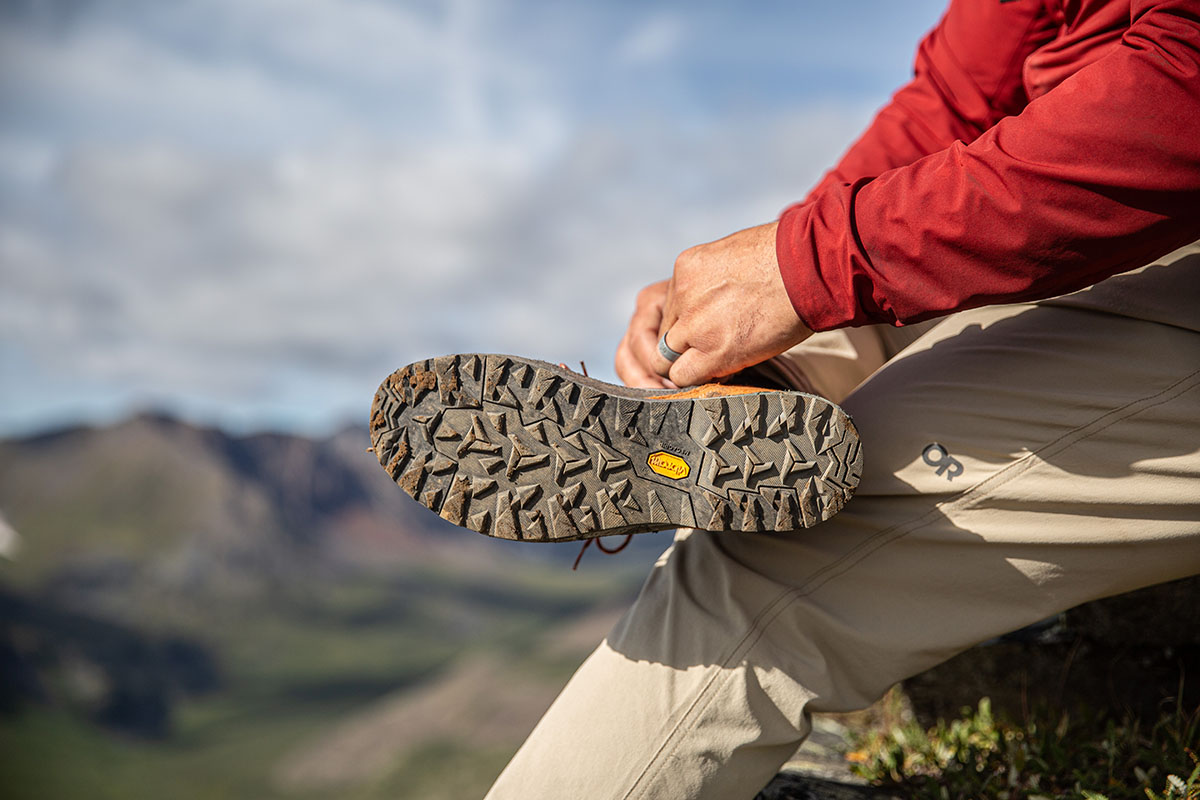
That said, there are plenty of in-house outsoles that have proven themselves just as high-performing as Vibram. For instance, Salomon uses its own proprietary outsole technology called Contagrip, which is available in both the X Ultra Mid and Quest 4. Drawing from years of experience in trail running and alpine sports, their outsoles are competitive with Vibram in both grip and durability. We've also had great experiences with the high traction outsole on Keen's Zionic series, which features multi-directional lugs that bite into loose dirt, wet roots, and submerged rocks with ease.
Stubbed toes are a rite of passage on the trail, but the right pair of boots can minimize the damage. Rubber toe caps or full toe rands are standard on most hiking boots and serve as armor against roots, rocks, and general trail hazards. Some models, like the Salomon Quest 4, feature beefy protection, which is great for scrambling or rough trails. On the flip side, ultralight boots—like the Altra Lone Peak 9—may skimp on this feature to save weight. From personal experience, we’d rather carry a couple extra ounces than sacrifice toe protection on technical trails. If you're planning to hike in rocky or mountainous areas, don't overlook this detail.
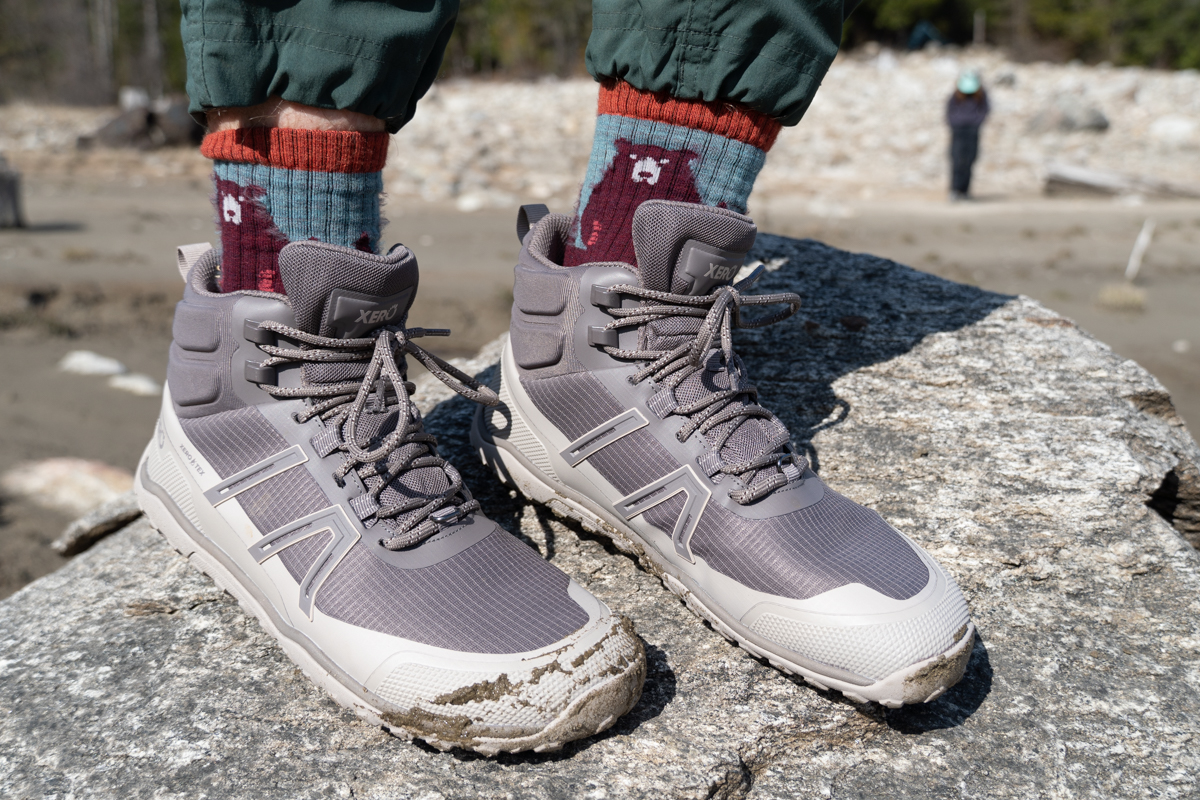
Even the best hiking boots often come with underwhelming stock insoles. They tend to be generic, flat, and not well-cushioned, which can lead to discomfort over time. The good news? Swapping out the factory insoles is easy and can dramatically improve the fit and feel of your boots. Brands like Superfeet offer a wide range of replacement insoles tailored for different foot shapes, arch types, and cushioning needs. A good insole can add volume to help fill out a loose boot, provide better arch support, or add just enough padding to reduce fatigue on long days.
Sustainability is gaining traction in the hiking world, and more brands are stepping up with eco-conscious designs. This includes using recycled or recyclable materials, bio-based fabrics, and repurposed components in their footwear. Many companies now highlight these features prominently—so if you care about your footprint, keep an eye out for sustainability tags on product pages or boot boxes. Another way to hike more sustainably is to choose durable footwear. Lightweight boots may save weight and feel nimble, but they often break down quicker. If you're willing to carry a few extra ounces and invest in break-in time, a burly leather boot can easily last a decade. Also worth considering are brands like Zamberlan, which offer repair services and resoling options. And when it’s finally time to retire your boots, look into recycling programs like Ridwell or TerraCycle that help keep gear out of the landfill.

A common question for trail-goers is whether to go with hiking boots or hiking shoes. Both have their place, and the right choice depends on the kind of terrain you're tackling, the weight of your pack, and your personal preferences. Boots offer more support and protection, especially around the ankles, making them ideal for rough terrain, snow, or carrying a heavy backpack. On the other hand, many experienced hikers and backpackers are leaning toward low-top hiking shoes or even trail runners. These options are lighter and more flexible, which can reduce fatigue over long distances. With proper training, many hikers find they don’t need the extra ankle support and enjoy the agility of shoes.
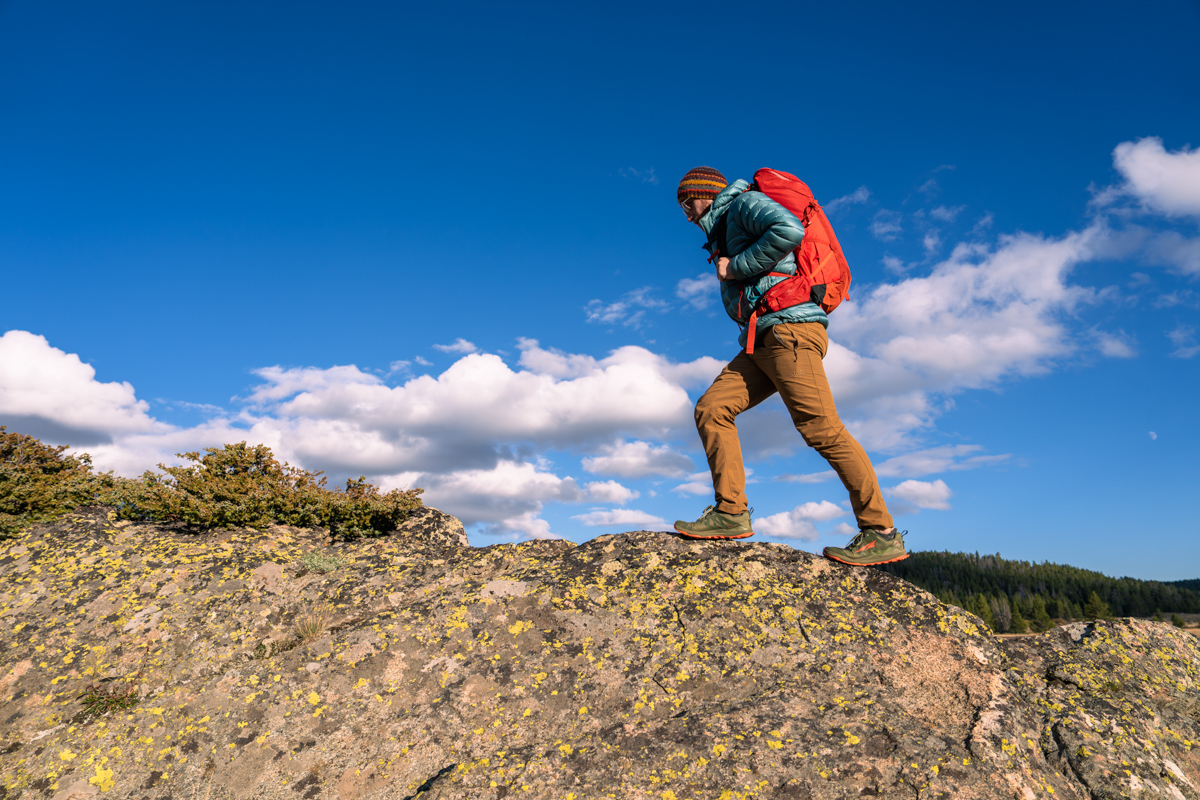
Still, for backpacking through rough country or hiking in cold, wet conditions, we usually reach for boots. That said, having both boots and shoes in your gear closet gives you the flexibility to match your footwear to your destination. Think of it this way: If you're serious about hiking, it's not a question of boots or shoes—it's a question of when to wear which.
Back to Our Top WP Hiking Boot Picks Back to Our WP Hiking Boot Comparison Tables